SUPPORT OUR JOURNALISM: Please consider donating to keep our website running and free for all - thank you!
- Meet the team
- Privacy Policy
- Royal Weddings
- Media & Commentary requests


Milestones of a Monarch: A controversial state visit to Yugoslavia
In October 1972, nearly a little over 20 years into her record-breaking reign, The Queen made history as she made her first state visit to a communist country, Yugoslavia.
Dictator Marshal Josip Broz Tito personally asked Her Majesty to come in honour of his 80th birthday. During the visit, she was accompanied by her husband, the Duke of Edinburgh, and their daughter, then-22-year-old Princess Anne, The Princess Royal. The crowds were packed on the sidewalks as the Royal Family made their way from the Surcin Airport to the Byzantine-style palace on Dedinje Hill where they stayed for their visit. During their stay, The Queen spent two days in Belgrade before embarking on a 780-mile tour throughout the region. The areas she visited are now known as Dubrovnik and Zagreb in Croatia.
The Queen actually has a royal link to the previous royal family of Yugoslavia, to who the Windsors were known to be close. The Queen and her late father, George V, are the godparents of Crown Prince Alexander – the last heir to the kingdom of Yugoslavia. At four months old, communist authorities deposed Alexander’s family.
In March 1953, Tito visited Buckingham Palace. This was an occasion noteworthy for it being the first time following World War II that a communist leader stepped foot inside a Western country. The Duke of Edinburgh was the first one to shake the leader’s hand. The trip also made headlines because, at a meeting at Downing Street, Tito insisted if Stalin were to attack his country, the West should intervene. A year prior to Her Majesty’s visit to Yugoslavia, in November 1971, Tito visited Britain once again on a state visit.
In the 1990s, the cultural and religious divisions between Yugoslavia’s ethnic groups would cause the country to fall. The land that was once known as Yugoslavia was split into Slovenia, Croatia, Bosnia and Herzegovina, Serbia, Montenegro, and Macedonia. Her Majesty returned to one of the countries, Slovenia, in 2008 when she visited Ljubljana and Kranj.
"; n.innerHTML = "window._taboola = window._taboola || [];_taboola.push({mode:'thumbnails-a', container:'taboola-below-article-thumbnails', placement:'Below Article Thumbnails', target_type: 'mix'});"; insertAfter(t, e); insertAfter(n, t) }injectWidgetByMarker('tbmarker');
Share this:
About author
Sydney zatz, latest posts, versailles: the glorious palace that also brought drama, if edward viii hadn't abdicated, who would be monarch today, the touching swedish ties behind queen mary's state banquet jewels, princess beatrice provides important update on her mother’s health amidst cancer battle, never miss the latest, most popular, the queen watches on with pride as lady louise drives prince philip’s carriages at windsor horse show, an annus horribilis in monaco a difficult year for albert and charlene finally winds to an end, the duchess of cambridge wows tv audiences with a musical piano performance on christmas eve, latest blogs.
Why did King Charles III wear two crowns on the day of the Coronation?
The history of the imperial state crown, the glittering symbol of monarchy worn by king charles at the coronation.
What really happened to Henry VIII's last queen? Inside the mysterious death of Katherine Parr
The Queen of travel
Queen Elizabeth II 1926 - 2022
Queen Elizabeth II leaves Fiji during a royal tour in February 1977. Serge Lemoine/Getty Images
The Queen of travel Journeys of a lifetime
By Francesca Street and Mark Oliver, CNN September 13, 2022
S he was traveling the moment she ascended to the throne, and for much of the next seven decades, Queen Elizabeth II criss-crossed the world. Newly married and still just a princess, Britain’s future monarch was in Kenya with husband Prince Philip in February 1952 when she learned of her father’s death and her new regal status.
During her reign she would visit more than 120 countries, witnessing first-hand the revolutions in global travel that shrank the world as her own influence over it diminished.
The Queen lived through the advent of the Jet Age, flew supersonic on the Concorde, saw regimes change, countries form and dissolve, the end of the British Empire and the rise of globalization.
Here are some of the most memorable travel moments from her 70 years as monarch.
November 24-25, 1953
Less than six months after she was crowned at Westminster Abbey in London, Queen Elizabeth set off on her travels again. Her debut official state trip was an epic six-month tour of the Commonwealth -- the alliance of nations which were once British colonies. Traveling by air, sea and land she visited several countries, accompanied by her husband, Prince Philip, the Duke of Edinburgh. First stop was the North Atlantic island of Bermuda, a British territory she would visit a further four times during her reign. The trip would go on to include stops in Jamaica, Tonga, New Zealand, Australia, Cocos Islands, Ceylon (now Sri Lanka), Aden (now part of Yemen), Uganda, Malta and Gibraltar.
December 19-20, 1953
At Queen Elizabeth’s coronation in June 1953, Queen Salote Tupou III of the Polynesian kingdom of Tonga won over the British public when she sat, rain-soaked, in her open carriage. They also took an interest when Elizabeth returned the visit later in the year. The two queens enjoyed an open-air feast, watched Tongan dancers and admired a tortoise that legend said was presented by explorer Captain James Cook to the King of Tonga in 1777.
December 23, 1953 – January 30, 1954
New zealand.
The Queen voyaged to New Zealand during the Antipodean summer of 1953-4. Over the course of the trip, it’s estimated that three out of every four New Zealanders got a glimpse of her. In preparation for the Queen’s visit, some New Zealand sheep were dyed in the UK flag colors of red, white and blue. The Queen returned to the country nine times over the years, including in 2002 as she marked half a century on the throne.
April 10-21, 1954
Ceylon (now sri lanka).
A visit to Ceylon, now Sri Lanka, coincided with the Queen’s 28th birthday. She visited the city of Colombo where crowds joined together to sing her “Happy Birthday.” She also visited the central city of Kandy, where she watched a procession featuring a reported 140 elephants and met local chiefs.
April 8-11, 1957
The Queen had visited France as a young princess, but her first state visit as monarch was a glamorous affair. She attended the Palais Garnier opera house in Paris, visited the Palace of Versailles, and dined at the Louvre with then-President Rene Coty. The Queen also laid a wreath on the Tomb of the Unknown Soldier at the Arc de Triomphe and visited the Scottish Church of Paris.
October 17-20, 1957
United states.
Having met President Harry S. Truman in Washington in 1951 during a visit before ascending to the throne, Elizabeth was no stranger to America when she arrived on her first trip as Queen. Her 1957 visit marked the 350th anniversary of the first permanent British settlement on the continent, in Jamestown. The monarch attended a college football game at the former Byrd Stadium in Maryland where she watched the home team lose to North Carolina. She met with President Dwight D. Eisenhower in the White House and later traveled to New York, where she and Prince Philip drove through the streets and admired panoramic views of the city from the Empire State Building.
February 1-16, 1961
The Queen and Prince Philip visited Pakistan in 1961, arriving in the port city of Karachi after completing a visit to India as part of a wider tour of South Asia. She drove through the streets of Karachi in an open-top car, before going on to visit Lahore, where a torchlight military tattoo took place in her honor and Prince Philip played in a game of polo.
February 26 to March 1, 1961
In Nepal, the Queen inspected troops in Kathmandu and met Gurkha ex-servicemen in Pokhara. The monarch rode on an elephant and visited the Hanuman Dhoka Palace complex in Kathmandu. She took part in the rather grim spectacle of a tiger hunt although didn’t shoot any animals herself. She instead recorded the experience on cine camera – a recording device that she often carried with her on her earlier foreign trips.
March 2-6, 1961
The Queen visited pre-revolution Iran at the end of her 1961 South Asian tour. Hosted by Shah Mohammad Reza Pahlavi, she toured ancient monuments including the ruins of Persepolis, once a capital of the Achaemenid Empire, later declared a World Heritage Site. She also saw Sheikh Lotfollah mosque in Esfahan and admired collections of the Archaeological Museum of Iran.
May 5, 1961
Vatican city.
In 1961, Elizabeth became the first British monarch to visit the Vatican. Dressed all in black, the Queen had an audience with Pope John XXIII, also attended by Prince Philip. She returned to the Vatican three more times during her reign, meeting Pope John Paul II and Pope Francis.
November 9-20, 1961
Bombing incidents in the capital Accra left officials worried about the safety of the Queen’s visit to Ghana but, after deliberation, UK Prime Minister Harold Macmillan confirmed it would go ahead. During the trip, the Queen famously shared a dance with Ghana’s then-president, Kwame Nkrumah. At the height of Cold War uncertainty, this seemingly innocuous moment was seen as significant in ensuring Ghana remained affiliated to Britain and not the USSR.
May 18-28, 1965
West germany (now germany).
The Queen’s visit to West Germany and West Berlin was viewed as a symbolic gesture of goodwill in the post-World War II landscape. It was the first royal trip to German territory for more than 50 years and photographs such as one of the Queen and Prince Philip in a car driving past the Brandenburg Gate had symbolic resonance.
November 5-11, 1968
Queen Elizabeth became the first reigning British monarch to visit South America when she landed in Brazil in late 1968. During the trip, the Queen wore a striking jewelry set made of Brazilian aquamarine, gifted to her in 1953 by the Brazilian president and added to over time. The monarch also attended a football match between Rio de Janeiro and Sao Paulo, and presented the winner’s trophy to Brazilian footballer Pele.
October 18-25, 1971
On the first of two trips to Turkey -- the second took place in 2008 -- the Queen visited the Gallipoli peninsula to remember the Allied soldiers who died there during World War I. The monarch also explored the ruins of the ancient Greek empire city of Ephesus. A media highlight of the visit came when she was photographed leaping ashore from a barge, after disembarking from her ship, the Royal Yacht Britannia.
February 10-15, 1972
Accompanied by Prince Philip and daughter Princess Anne, the Queen was greeted on arrival in Bangkok by a carpet of flower petals. The monarch was given a golden key to the city of Bangkok, attended a state banquet and visited Bang Pa-In Palace, the Thai royal family’s summer residence, north of the capital.
October 17-21, 1972
The Queen’s visit to Yugoslavia was her first trip to a communist country. The Central European country no longer exists -- the areas that the Queen visited are now part of Croatia. During her trip, she met Yugoslav political leader Josip Broz Tito and traveled on his famous Blue Train.
February 15-16, 1974
New hebrides (now vanuatu).
The Queen and Prince Philip visited the Pacific island archipelago of Vanuatu, then known as the New Hebrides, in 1974. It’s said the royal couple’s visit to Vanuatu may have strengthened the belief among some locals on Tanna island that the Duke of Edinburgh was a divine being.
February 24-March 1, 1975
On her first of two visits to Mexico, the Queen toured ancient sites -- including the pyramids of Uxmal, now a UNESCO World Heritage Site. The monarch also received local crafts, met school children and attended a banquet. While she was driven through Mexico City, the Queen was showered in confetti.
February 17-20, 1979
Saudi arabia.
In 1979, the Queen became the first female head of state to visit Saudi Arabia, on a tour of Gulf States. At Riyadh Airport, she was met by King Khalid bin Abdulaziz Al Saud, pictured. The outfits she wore on the trip were carefully designed in accordance with Saudi Arabia’s conservative dress code for women. The Queen arrived on a British Airways supersonic Concorde aircraft and during the visit attended camel races and toured the National Museum.
October 26-27, 1982
The Queen visited Tuvalu, a group of nine islands in the South Pacific, in 1982. Upon arrival, the Queen and Prince Philip were carried in a flower-filled canoe from sea to shore. Thirty years later, in 2012, Prince William visited Tuvalu with his wife, the Duchess of Cambridge, who drank a coconut from a tree planted by Queen Elizabeth on this 1982 visit.
February 26 – March 6, 1983
On a star-studded trip to the United States, the Queen toured the 20th Century-Fox studios in Hollywood with then-First Lady Nancy Reagan and met Frank Sinatra, who she’d previously met in the 1950s, at a party given in her honor. The Queen and Prince Philip also visited Yosemite National Park in California, pictured.
November 10-14, 1983
The Queen returned to Kenya in 1983 for a state visit. When she was there 31 years previously, she'd learned that her father had passed away and she had become Britain’s reigning monarch. In 1983, the Queen and Prince Philip revisited the Treetops hotel, pictured, where they were staying at the time she was told the news.
October 12-18, 1986
The Queen’s trip to China was the first -- and, so far, only -- state visit by a British monarch to China. With Prince Philip by her side, the Queen visited the Great Wall of China, pictured, as well as the Forbidden City in Beijing.
October 17-20, 1994
In 1994, in another royal first, the Queen visited Russia. Over the three-day trip, the Queen met Moscow mayor Yuri Luzhkov, pictured here with the monarch outside St Basil’s Cathedral, as well as Russian President Boris Yeltsin. The Queen also attended the Bolshoi Ballet. In her traditional Christmas Day speech broadcast later that year, the Queen reflected on how times had changed, noting she “never thought it would be possible in [her] lifetime” to attend a service in Moscow’s famous cathedral.
March 19-25, 1995
South africa.
In 1994, after apartheid ended, South Africa rejoined the Commonwealth as a republic. The following year, the Queen traveled there, in a visit designed to renew ties between the two countries. The Queen met with President Nelson Mandela, pictured, and presented him with the Order of Merit.
October 12-18, 1997
The Queen visited India for the third time in 1997, her first public engagement since Princess Diana’s funeral just weeks before. The trip marked 50 years since India’s independence from Britain. Most memorably, the monarch visited the site of the Amritsar massacre, also known as the Jallianwala Bagh massacre, of April 13, 1919. She also expressed regret at a state banquet in New Delhi for the “distressing” episode in which British soldiers gunned down hundreds of unarmed civilians. The gesture was seen by some as inadequate. “The Queen is doing everything she can to make India like her. But so far it does not seem to be working,” wrote the UK’s Independent newspaper at the time.
October 4-15, 2002
The Queen visited Canada many times. In 2002, her trip to the North American country coincided with her Golden Jubilee festivities, celebrating 50 years of her reign. During the trip, the Queen attended an ice hockey game between the Vancouver Canucks and the San Jose Sharks, and dropped the ceremonial puck.
March 11-16, 2006
The Queen visited Australia 16 times as Head of State. In 2006, she traveled to Melbourne to open the Commonwealth Games. She was greeted by a welcoming party in Canberra, visited the Sydney Opera House, attended a Commonwealth Day service in St. Andrew’s Cathedral and toured Admiralty House, the Sydney residence of the Governor-General of Australia.
May 17-20, 2011
The Queen’s trip to Dublin was the first time a British monarch had set foot in the Irish Republic since its 1922 independence. At Dublin Castle the Queen delivered a well-received speech on the history of Anglo-Irish relations. In County Tipperary, she also toured the medieval Rock of Cashel, pictured, once a seat of power for Ireland’s ancient kings.
November 26-28, 2015
From 1949 to 1951, before she was Queen, Elizabeth and Prince Philip lived in Malta. In 2015, the monarch paid her last visit to the island, touring the Grand Harbour in a Maltese fishing boat and waving to members of the British Royal Navy.
United Kingdom
In the later years of her reign, the Queen cut back on foreign travel, passing on the mantle to the younger royals. In more recent years, royal tours have also been looked at with more skeptical eyes, as Britain reckons with its colonial past.
While she didn't travel abroad in the later years of her reign, the Queen continued to vacation in the UK. Most notably, the Queen’s ties with Scotland remained strong throughout her reign and her residence there, Balmoral Castle, was a favorite refuge. It was at Balmoral that the Queen died on September 8, 2022.


Jennifer Lopez Takes Naked Dressing to New Heights in Sheer Gown at 2024 Met Gala That Took 800+ Hours to Make
Lopez serves as co-chair for this year's glam event
Kendall Jenner flashes her bum in never-worn vintage dress at the 2024 Met Gala
Kendall Jenner attended the 2024 Met Gala looking incredible in a dress with bum crack cut-outs. Her vintage archival Givenchy gown has never been worn before.
Prince Harry 'torn' between Meghan and his return to Britain
EXCLUSIVE: Prince Harry has landed in the UK without his wife Meghan Markle - and a source tells OK! that the couple may be on very different pages when it comes to their return to Britain.
Nicola Sturgeon reacts to John Swinney becoming Scotland's new first minister
NICOLA Sturgeon has reacted to John Swinney becoming Scotland’s new First Minister...
Vladimir Putin inauguration: Steven Seagal and other famous faces spotted at Kremlin palace
Vladimir Putin began his fifth term as Russian president at a palace in Moscow in front of a crowd of faces - including actor Steven Seagal and the leader of a biker gang. At the ceremony in the gilded Grand Kremlin Palace, Mr Putin placed his hand on the Russian Constitution and vowed to defend it as a crowd of hand-picked dignitaries looked on. The US actor, known for films such as Under Siege and On Deadly Ground, is an ally of Mr Putin.
Ex-DOJ Official Stunned By Trump Hand Gesture In Court: ‘Can’t Begin To Fathom’
Neal Katyal also summed up the latest defense by the former president's legal team in his hush money trial as "atrocious."
- Conversations
- Success Stories
- Business News
- World Entrepreneur
- Environment
- Food & Drinks
- Real Estate
- Chambers of Commerce
- Cultural Centres
- Municipalities
- Special Editions
- Appointments
- Announcements
- Philanthropy
- Upcoming Events
CorD Recommends
Slađana Prica, retired ambassador, member of the Forum for International Relations and honorary president of the UNA of Serbia
Diplomatic Response Overdue
Slobodan G. Markovich, Institute for European Studies and Faculty of Political Science
U.S. Elections More Critical for EU Future than EP Elections
Ivana Radić Milosavljević, Assistant Professor in European Studies at the University of Belgrade - Faculty of Political Sciences
Not all Right-Wing Parties are Likeminded
Rajko Petrović, Research Associate at the Institute of European Studies
The EU Idea is Stronger than the Outcome of Less Important Elections
Slovenia to outpace italy in economic power by 2029, serbia to receive €1.63 billion in eu funding for western balkans growth plan, eu parliament passes stringent packaging laws, serbia’s gaming industry sees significant growth and employment surge in 2023, maserati’s balkan expansion: new showroom opens in belgrade, slobodan g. markovich, mbe, head of the centre for british studies, faculty of political science, belgrade, hm queen elizabeth ii, serbia and yugoslavia.
In the history of the British monarchy, Queen Elizabeth II (1926-2022) was the longestreigning sovereign. She was the queen of the United Kingdom and Commonwealth realm for more than 70 years. During her long life and reign, she took part in several events relevant for British-Serbian and British-Yugoslav relations
Her father, Prince Albert, Duke of York (1895-1952) became King George VI in 1936 and reigned till 1952. He was the first person from the British Royal family to establish close relations with Serbia and Yugoslavia and participated in at least five symbolically important events that linked Serbia and Yugoslavia with Britain. In the early spring of 1916, Crown Prince and Regent Alexander of Serbia visited Britain. On that occasion, Prince Albert received the Prince Regent at Charing Cross station in London and escorted him to see his father King George V. That was the first visit of a Serbian head of state to the United Kingdom. The Times reported that: “the reception accorded the Crown Prince outside the station was magnificent, and no foreign visitor has been more warmly received.” (The Times, 1st April, 1916). This was a u-turn in mutual relations since the Belgrade regicide of 1903 had produced a particularly negative impression in Britain and even led to a three-year-long break in diplomatic relations. The Great War turned everything around, and British public opinion became the champion of its small and heroic ally, Serbia. The British court endorsed this kind of appraisal during the visit of the Prince Regent to London.

After the end of the Great War, Prince Albert twice visited Belgrade. On 8th June, 1922, Prince Albert acted as ‘kum’ (chief witness / godfather) at the royal wedding of King Alexander Karađorđević and Princess Marie of Romania, great-granddaughter of Queen Victoria. On that occasion, Prince Albert represented his parents, the King and the Queen. (The Times, 9th June, 1922). In October 1923, he came again, this time to attend the christening of the infant son of Queen Marie and King Alexander. On 20th October, the Duke and Duchess of York were greeted in Belgrade, in front of the royal palace, where “in spite of the cold, large crowds awaited the arrival of the Koom and Koomitsa [Godfather and Godmother].” The Duke of York held the baby throughout the service, as Christian Orthodox tradition demands, and Serbian Patriarch Dimitrije conducted the ceremony.
(The Times, 21st October, 1923). It is important to mention that the Serbian word “koom” (or kum in more modern spelling) can denote both a best man at a wedding and a godfather or godmother at a christening. The Duke of York represented his father as the best man of King Alexander in 1922 and was godfather to his son in 1923. The baby was named Peter, after his grandfather Peter I the Unifier. The Duke of York also acted as the best man at the wedding of Prince Paul two days later. Prince Albert was the second son of King George V, who was succeeded by his eldest son Edward VIII (r. January-December 1936), and only after his abdication did the Duke of York become the king of the United Kingdom as George VI.

On 20th March, 1944, King Peter of Yugoslavia married Princess Alexandra of Greece and Denmark. On that occasion, King George VI and King George of Greece acted as witnesses. Finally, on 24th October, 1945, the christening of Crown Prince Alexander took place at Westminster Abbey in London, in the presence of King George VI and Queen Elizabeth. King George VI and his daughter Princess Elizabeth were godparents to the Crown Prince Alexander of Yugoslavia. The ceremony was conducted by Patriarch Gavrilo and Bishop Nikolai Velimirovich, in the presence of the Archbishop of Canterbury. (The Times, 25th October, 1945) Princess Elizabeth was 19 at the time of this ceremony and held the Crown Prince in her hands. The event made such an impression on her that, many decades later, she vividly described that moment to several Serbian diplomats.
Although the Kingdom of Yugoslavia was an official British ally until 1945, the victory of the Yugoslav communist-led Partisans in the civil war led to the suspension of the Yugoslav monarchy in November 1945. In the first years of communist Yugoslavia, its relations with both the U.S. and the UK were fraught with tension. Everything changed suddenly in June 1948, when the Soviet Union expelled Yugoslavia from the association of communist countries.
50 years ago, on October 1972, Queen Elizabeth, accompanied by Prince Philip and their daughter Anne, made a four-day visit to Yugoslavia. It was the first communist country she visited
After that, Yugoslavia found unlikely allies in the Western countries. In the 1950-53 period, communist Yugoslavia received assistance from the U.S. and UK, and the Yugoslav leadership visited Britain in March 1953. It was the first meeting of Yugoslav leader Josip Broz Tito and Queen Elizabeth, but since the Queen had not yet been crowned, it did not have the rank of an official visit, but rather a “private own”. Nevertheless, Yugoslav President Tito was received with full pomp, which was very important for him because, at this time, Yugoslavia was making efforts to build bridges with Western states.
The rapprochement between the two states proved rather short-lived. The Suez Crisis in 1956 brought the two countries into a new dispute, which was amplified during the decolonisation of British Africa between 1956 and 1966. Yugoslavia’s direct opposition to Israel in 1967 was another low point. Only after the Soviet invasion of Czechoslovakia in the summer of 1968 did Communist Yugoslavia try to re-establish warmer relations with the West, including Britain. In the 1970s, mutual relations reached a new high point that included several visits on both sides. In November 1971, the Yugoslav President made his first one-day official visit to the UK and had lunch with the Queen at Buckingham Palace. The visit was organised under “unusually stringent security precautions.” (The Times, 8th November, 1971).

In October 1972, Queen Elizabeth, accompanied by Prince Philip and their daughter Anne, made a four-day visit to Yugoslavia. It was the first communist country she visited, and that very fact was not received favourably in some quarters in the West. In Britain, the visit was seen “as yet another step in the readjustment of the British monarchy to the requirements of present-day realities.” (The Times, 17th October, 1972) At that moment, Yugoslavia was going through a deep crisis due to the re-emergence of ethnic tensions and the persecution of intellectuals, students and dissidents by the Yugoslav communist regime, which prompted criticism in many circles in the West. Under such conditions, Belgrade gave the Queen an “enthusiastic reception despite the political crisis”. British journalists were somewhat surprised that the Queen’s host, Yugoslav President Josip Broz Tito, who was “unusually stern”, could not wait with his announcement about the withdrawal of his support from the Serbian Party leadership till the visit was over.
During their visit, the Queen and Prince Philip laid a wreath at the Tomb of the Unknown Hero at Avala Mountain. The Queen also planted a tree in the Park of Friendship and visited the Commonwealth War Cemetery and the University of Belgrade. She spoke “of the traditional respect and understanding between Britons and Serbs and of the sincere admiration the British have for the long and courageous Serbian struggle, first to achieve freedom and then, with other constituent republics of the Yugoslav federation, to build a united nation.” The Queen also mentioned the dangers of neglecting the environment in the age of modern technology: “You cannot feed the beauty of the countryside into a computer and statistics cannot themselves make clean air, sparkling rivers or contented community.” (The Times, October 19, 1972).

The Queen was awarded the golden plaque of the City of Belgrade by its mayor. On that occasion, she said at the Belgrade City Hall: “Some 50 years ago, my father and mother were in a position to visit Belgrade and therefore I am particularly happy to be here with my husband and daughter.” (Politika, 18th October, 1972) This was a discreet reminder to the Queen’s hosts of the relations her family had had with the Yugoslav royal family.
During her trip, the Queen also visited Zagreb, where “a crowd of 15,000 people applauded”, and spoke of the close contacts between Britain and Croatia. As Dessa Trevisan of The Times noted: “The toast was addressed to the Serbs in Belgrade and to the Croatians in Zagreb, reflecting the Queen’s awareness of the delicate relationship between the two largest nations of Yugoslavia.” (The Times, 21st October, 1972).
Visits continued in the 1970s, and President Tito paid a short visit to the UK in March 1978, then in October that same year, Prince Charles visited Yugoslavia. At the funeral of the Yugoslav President in May 1980, the British delegation included Prince Philip, Prime Minister Margaret Thatcher and Foreign Secretary Lord Carrington.
The official visits in the 1970s happened in the period when Josip Broz, the Yugoslav life-long president, after he met with Brezhnev in Belgrade in 1971 and again in June 1972 in Moscow, was seen in the West as getting too close to the Soviet Union. In retrospect, one can see that the Queen’s visit to Yugoslavia took place between Tito’s visits to Moscow in 1972 and 1973.
What happened in the early 1950s when communist Yugoslavia came closer to the West is nowadays known in historiography as a “Cold War anomaly”. A new climax in British-Yugoslav relations took place in the 1970s. In 1988, one of the last British ambassadors to Communist Yugoslavia, Andrew Wood, aptly summarised the process begun in 1948: “A British-Yugoslav marriage of convenience had nevertheless begun – and marriages of convenience are often the most durable.”
Communist Yugoslavia collapsed in 1991 and the Wars for Yugoslav Succession followed. The Queen never returned to Yugoslavia or Serbia after 1972. In 1995, she attended the 50th birthday celebration of Crown Prince Alexander in London and danced a waltz with the Crown Prince, whom she had baptised half a century earlier.

Finally, in 2016, Prince Charles and Camilla, Duchess of Cornwall, made a regional tour and visited Zagreb, Belgrade, Priština and Podgorica. During his visit to Belgrade and Serbia, Prince Charles, in addition to official meetings with the officials of Serbia, had special meetings with the Serbian Patriarch and the Friends of Mount Athos (FOMA) and paid a visit to the Temple of St. Sava in Belgrade and Kovilj Monastery. He also visited Crown Prince Alexander and was shown an exhibition on the mutual contacts between the two dynasties. On 17th March, 2016, in his address in the National Assembly of Serbia, he singled out some historical and public figures that symbolised relations between the United Kingdom and the region, including Father and Bishop Nikolai Velimirović, Flora Sandes, Fitzroy Maclean, Rita Ora, Novak Đoković and Mother Theresa.
What emerges from this short review is that, in one hundred years spanning from 1916 to 2016, the British Royal family gave a very important contribution to the development of British-Serbian, British-Yugoslav and British- Balkan relations.
- Elizabeth II
- Slobodan G. Marković
Published since 2003 by
Copyright © CorD Magazin 2003-2024. All rights reserved.
- Culture Conversations
- Faces & Places
- Video Events
The million mile Queen
Our most travelled monarch has covered at least 1,032,513 miles and 117 countries (out of a possible 195) during her reign. from marshal tito's communist yugoslavia to president george w bush's usa, we look back at some of the queen's more memorable state visits.
By Tom Rowley , Méabh Ritchie and Ashley Kirk
Three weeks after the Queen ascended the throne in 1952, The Daily Telegraph published a letter from Colin Thornton-Kemsley, an MP. Stressing “the burdens of Queenship”, Sir Colin hoped that the new monarch would “make extensive Commonwealth tours, of which the itineraries and programme will be so arranged as to provide ample opportunities for rest and recreation”.
In the 64 years since, the Queen has certainly made extensive tours. Rest and recreation? Less so.
The Telegraph has calculated that she has travelled at least 1,032,513 miles as Queen, simply journeying to and from the countries she has visited on state and Commonwealth tours. Even this remarkable total is some way short of the true figure, since it assumes as the crows flies travel and excludes travel within each country as well as domestic travel.
The Queen has travelled 1,032,513 miles as Queen, equivalent to 42 journeys around the entire circumference of the Earth.
The total, which highlights her record as our best travelled monarch, is equivalent to 42 journeys around the entire circumference of the Earth. While the average Briton has visited seven countries , Her Majesty has toured at least 117, not including brief stops (for refuelling for example). Nor were the trips often short: Britons most often visit Spain but the Queen has spent the most time in Australia.
The new sovereign set the pace on her first tour, in the winter of 1953-4. During her two months in Australia, she travelled an average of 230 miles a day. The English equivalent, The Daily Telegraph explained at the time, would mean taking the train from London to Bournemouth before flying to Hull, then repeating that journey for 58 days.
To celebrate the Queen’s 90th birthday, we dived into our archives to illustrate some of our best-travelled monarch’s most extraordinary foreign adventures. The Telegraph has chronicled every one of those million miles – in words and pictures and, now, in videos, live blogs and tweets, too.
If you haven’t heard the one about the Queen and the talking horse, read on…
Note: Miles calculated on as the crow flies distances, taking London as the starting point of each tour. She will have travelled many thousands of miles more, since this total excludes travel within each country and domestic travel.
The 117 countries visited by the Queen, out of a possible 195, during her reign
1952: Kenya
She arrived in Kenya on 1 February as Princess Elizabeth. Six days later, she flew home as Queen. Her father, King George VI, was originally due to carry out the tour, which was meant to continue to Australia and New Zealand, but sent his daughter instead, citing doctors’ advice. On 6 February, he died in his sleep at Sandringham .
Princess Elizabeth was staying with the Duke of Edinburgh at Sagana Lodge, which had been their wedding present from the Kenyan government. She was planning a riding and fishing trip when she was told the news, reported Frank Harvey, The Telegraph’s special correspondent at the time. She flew straight back to London Airport, where she was greeted by 17 Cabinet ministers. She still found time to write to Sir Philip Mitchell, Governor of Kenya, to thank the country’s people for their “wonderful welcome”. “It was a great pleasure to meet so many subjects of the late King whom I am now proud to call my own,” she wrote.
In the years to come, the Queen returned to Kenya three times.
How The Telegraph reported the visit at the time
Photo: Princess Elizabeth and the Duke of Edinburgh attend a polo match at Nyeri in Kenya, 3 February 1952 (Getty)
1954: Australia
“Let’s face it,” one Australian told The Telegraph mid-way through the first tour of his country by a reigning monarch, “we have gone Queen crazy.”
One and a half million Australians thronged the streets of Sydney on her arrival , 40,000 turned up to see her lay a wreath, 50,000 sang “Land of Hope and Glory” when she reached Brisbane, and when she and the Duke of Edinburgh went to church, 3,000 sat outside. The royal party switched to a train for part of the tour, so frequently was their car halted by locals shouting “Good on you, Phil” and “Good on you, Liz”. At one function, the Queen was presented with 161 bouquets; at another, she was given five tons of dried fruit.
In her 58 days in the country, she made 35 flights, and travelled 13,000 miles. It marked the start of Her Majesty’s enduring attachment to Australia, the foreign country in which she has spent the most time. (The second is Canada.) She opened five parliaments, unveiled two war memorials, toured a steel works and an open-cast coal mine and watched a children’s bush pantomime. At a state banquet, The Telegraph reported “there were tears in the Queen’s eyes when Mr Menzies, Prime Minister, said: ‘You are in your own country, among your own people… we are yours’”.
Photo: Queen Elizabeth II's Royal Tour of Australia (News Ltd/Newspix / Rex Features)
1966: British Guiana
The “winds of change” that blew across Britain’s former Empire in the first three decades of the Queen’s reign battered the Royal Yacht Britannia when she docked in British Guiana in February 1966, just 111 days before the country was due to become independent from Britain.
The Queen went ahead with the planned stop at the beginning of a Caribbean tour, despite an opposition party’s plans to boycott the visit and a sizeable police presence. Opposition benches were empty when she visited Parliament and a plastic bag containing bullets and cartridges was discovered on the royal train route.
But locals lined the streets, cheering the royal party, and 10,000 children attended a rally in her honour. When she set sail again, an impromptu crowd gathered at the harbour, wearing bright shirts and straw hats.
The Queen went ahead with the planned stop, despite an opposition party’s plans to boycott the visit and a sizeable police presence
They began to give the Queen a calypso send-off, sending her “swaying at the rails of Britannia, her diamond earrings bobbing,” according to The Telegraph’s correspondent. “Sir Richard Luyt, the Governor, broke into what can only be described as a soft shoe shuffle.”
Photo: The Queen and Prince Philip watch a demonstration of diamond panning at La Belle Intention, a sugar plantation near Georgetown (AP)
1972: Yugoslavia
It was, wrote The Telegraph’s Communist Affairs Correspondent (who else?), a “strange encounter”. At the height of the Cold War, the Queen accepted an invitation from President Josip Tito to visit Yugoslavia, the first time she had travelled to a Communist country.
Behind the Iron Curtain, Union flags were hung from workers’ tower blocks and a palace was prepared to host the Queen, the Duke of Edinburgh and the Princess Royal. Tito greeted them in person on the tarmac.
The Socialist alliance claimed the five-day visit was based on “common allegiance to peace, equality among peoples and world progress”.
At a state banquet, the Queen stressed rather different ties between the two countries. “We in Britain are particularly proud of our contribution to the [Second World War] resistance and to the liberation of Yugoslavia from enemy occupation,” she said.
Photo: HM Queen Elizabeth II being greeted by President Tito (UPI)
1991: Zimbabwe
The Queen smiled – perhaps a little warily – as she clinked glasses with Robert Mugabe, President of Zimbabwe, at a dinner in honour of her visit. In all those thousands of days away from home, it was inevitable that Her Majesty would occasionally have to endure some unpalatable company.
Her visit to Harare coincided with a Commonwealth summit, for which she regularly travelled around the world. Other Commonwealth meetings took her to Cyprus, Nigeria, Uganda and South Africa. Her last visit to Zimbabwe, when it was still known as Rhodesia, was in 1947 with her father, King George VI.
Determined to make a positive impression, the capital’s streets were cleared of prostitutes. But it nevertheless received negative attention for its recent series of blackouts, dwindling water supply and shortage of ambulances. Motorists were forced from the roads as authorities carried out several “dummy runs” on the route the Queen would take. “Of course it is annoying,” a taxi driver told The Telegraph, “but today is for the Great Mother.”
Photo: Queen Elizabeth II toasts with Zimbabwean President Robert Mugabe (Howard Burditt / Reuters)
1993: Hungary
During the Queen’s first visit to a former Eastern bloc country following the fall of the Berlin Wall, she stayed in a Soviet-era state-run guesthouse. “It resembles an airport terminal from the outside and an ageing motel within,” wrote The Telegraph’s Robert Hardman in Budapest. “The British Embassy diplomatically describes the bland, brown interior as ‘biscuit décor’.”
Yet Her Majesty enjoyed a colourful – and historically significant – visit, which was followed in later years by travels to Russia, Poland, the Czech Republic and the Baltic States. The Queen was granted the freedom of the city and took a trip up the Danube, averting her gaze when the boat passed a bunch of topless sunbathers on the bank. When she addressed the first freely-elected parliament in Eastern Europe, “even the Socialist Party applauded long and loud”.
For many Hungarians, it was a novel experience simply to watch a state occasion without being ordered. “People will be watching because they want to,” said Arpad Goncz, the President. “No one is going to smile by command.”
Photo: The Queen and Prince Philip in a horse drawn carriage in Budapest (Ian Jones)
2007: America
“Americans are just gaga over this visit,” reported the New York Times’s White House correspondent during what was only the Queen’s fourth state visit to the United States during her reign. (She has spent more time in Malta.)
In preparation for the visit, to mark the 400th anniversary of the first British settlers’ arrival in Jamestown, the White House windows were specially cleaned and a royal etiquette book was circulated. Photographs of earlier royal visits were put on display.
The Queen had previously been hosted by George HW Bush, Gerald Ford and Dwight Eisenhower – but not by Ronald Reagan, Richard Nixon nor Bill Clinton.
George W Bush may have thought the visit a great honour, too, but he was reportedly perturbed to have to change his informal habits. Seven years into his presidency, this was the first time he wore a white tie and tails, and even then supposedly at the insistence of the First Lady. The White House social secretary was quoted in The Telegraph saying: “I think Mrs Bush is thrilled to have a white-tie dinner, and we’ll leave it at that.”
Photo: President Bush Hosts Queen Elizabeth At The White House (Win McNamee / Getty)
2011: Ireland
When George V visited Dublin in 1911, the entire island remained under his dominion. It took an – often turbulent – century for another sovereign to visit, and when his granddaughter landed, she was the first British monarch to set foot in the Irish Republic.
“Years of delicate diplomatic groundwork finally came to fruition when the door of the Queen’s BAe 146 opened at Casement military air base, and the Republic got its first glimpse of the sovereign, dressed, of course, in green,” wrote Gordon Rayner, The Telegraph’s chief reporter.
Unprecedented security measures were put in place for the four-day visit, with exclusion zones extending hundreds of yards from each site the royal party visited and 8,000 police and soldiers on the street. But there was time for some pure pleasure when the Queen visited the Irish National Stud, one of the republic’s leading horse breeding centres, and chatted to trainers, breeders and jockeys.
During an address at the end of her visit, she referred to the IRA’s murder of Earl Mountbatten, the Duke of Edinburgh’s uncle. But she emphasised that we should “bow to the past, but not be bound by it”.
Photo: Queen Elizabeth II bows her head at the Irish War Memorial Gardens (AP)
2015: Malta
They played Thanks For The Memory as the Queen arrived in Malta last November. It was a fitting choice for a nostalgic visit to the country where she and the Duke of Edinburgh lived for two years at the start of their marriage and where she has since returned six times.
The official purpose of the state visit was to attend a Commonwealth Heads of Government Meeting. But it also gave her the opportunity to reflect on the time she and the Duke spent on the island, when the Duke was based there with the Royal Navy. Marie-Louise Coleiro Preca, the country’s president, presented the Queen with a watercolour of the villa where they used to live. “We thought it would bring back memories,” the president said.
At a reception one evening, one guest was Freddie Mizzi, who was a clarinettist when the Queen and the Duke used to go dancing at the Venetian Hotel in Valletta in the early Fifties. “She and the Duke used to dance a lot,” Mr Mizzi reminisced in The Telegraph. “She is still beautiful and when you talk to her it’s like talking to a member of your family. I always called her Auntie Lizzie.”
The Queen landed at the same spot as her father did when he gave Malta the George Cross pic.twitter.com/ZaKvMMoeSn — Gordon Rayner (@gordonrayner) November 28, 2015
The red puddle awaits the Queen at the presidential palace in Valletta pic.twitter.com/pRDhVDOX98 — Gordon Rayner (@gordonrayner) November 26, 2015
Queen arrives at Presidential palace in Malta on gloomy afternoon pic.twitter.com/NK9OBoa60X — Gordon Rayner (@gordonrayner) November 26, 2015
Photo: Queen Elizabeth II embarks on a boat for a trip across Valletta Harbour, from Kalkara to Customs Wharf in Malta (Mark Cuthbert/PA)
Read more coverage at Telegraph/the-royal-family Find more in-depth features at Telegraph/in-depth
Designer: David Stevenson
All data taken from Buckingham Palace archives
1950s : Panama, Bermuda, Jamaica, Fiji, Tonga, New Zealand, Australia, Cocos Islands, Ceylon (Sri Lanka), Yemen, Uganda, Malta, Gibraltar, Norway, Nigeria, Sweden, Portugal, France, Denmark, Canada, United States, The Netherlands, Canada
1960s : India, Pakistan, Nepal, Iran, Italy, Vatican City, Ghana, Liberia, Sierra Leone, Gambia, Canada, Fiji, New Zealand, Australia, Canada, Ethiopia, Sudan, Germany, Canada, Barbados, British Guiana, Trinidad & Tobago, Grenada, St Vincent, St Lucia, Dominica, Montserrat, Antigua, St Kitts, Nevis, British Virgin Islands, Turks and Caicos Islands, The Bahamas, Jamaica, Belgium, Malta, Brazil, Chile, Austria
1970s: Canada, Fiji, Tonga, New Zealand, Australia, Turkey, Thailand, Singapore, Malaysia, Brunei, Maldives, Seychelles, Mauritius, Kenya, France, Yugoslavia, Cook Islands, Norfolk Island, New Hebrides, British Solomon Islands, Papua New Guinea, Indonesia, Bermuda, Barbados, The Bahamas, Mexico, Jamaica, Hong Kong, Japan, Finland, United States, Luxembourg, Western Samoa, British Virgin Islands, Antigua, Germany, Kuwait, Bahrain, Saudi Arabia, Qatar, Abu Dhabi, Dubai, Oman, Denmark, Tanzania, Malawi, Botswana, Zambia
1980s : Switzerland, Australia, Italy, Vatican City, Tunisia, Algeria, Morocco, Norway, New Zealand, Sri Lanka, Canada, Papua New Guinea, Solomon Islands, Nauru, Kiribati, Tuvalu, Fiji, Bermuda, Jamaica, Cayman Islands, Mexico, Sweden, Cyprus, Kenya, Bangladesh, India, Jordan, Portugal, Belize, The Bahamas, Little Inagua Island, St Kitts-Nevis, Antigua, Dominica, St Lucia, St Vincent and the Grenadines, Barbados, Grenada, Trinidad and Tobago, Nepal, China, Hong Kong, Spain, Singapore, Malaysia
1990s: New Zealand, Iceland, Canada, United States, Kenya, Namibia, Zimbabwe, Australia, Malta, France, Germany, Hungary, Cyprus, Anguilla, Dominica, Guyana, Belize, Cayman Islands, Jamaica, The Bahamas, Bermuda, Russia, Poland, Czech Republic, Thailand, Pakistan, India, Brunei, Malaysia, South Korea, Ghana, South Africa, Mozambique
2000s : Australia, Italy, Norway, Jamaica, New Zealand, Canada, Nigeria, France, Germany, Malta, Singapore, Lithuania, Latvia, Estonia, The Netherlands, United States, Belgium, Uganda, Turkey, Slovenia, Slovakia, Bermuda, Trinidad and Tobago
2010s: Canada, United States, The United Arab Emirates, Oman, Ireland, Australia, Italy, Vatican City, France, Germany, Malta
- Share full article
Advertisement
Supported by
Big Crowds in Belgrade Greet Queen Elizabeth
BELGRADE, Yugoslavia, Oct. 17 (Reuters)—Thousands of Yugoslays thronged flagdecked streets today to give Queen Elizabeth II of Britain a arm weicome to Belgrade.
The crowds packed sidewalks four to five deep in places to watch the Queen and President Tito drive by in an open car on their way from Surcin Airport to the Byzantine‐style palace on Dedinje Hill where the Queen and her party will stay.
The Queen, accompanied by Prince Philip and their 22 — year — old daughter, Princess Anne, received a redcarpet greeting at the airport from Marshal Tito, his wife and high Yugoslav officials.
Queen Elizabeth, making her first visit to a Communist country, is spending two days in Belgrade before starting a 780‐mile tour that will take her to some of Yugoslavia's most popular scenic areas.
- AI Generator
Royal Tour of Yugoslavia: Queen visits Belgrade Castle Museum

Get personalized pricing by telling us when, where, and how you want to use this asset.
- Elizabeth II ,
- Former Yugoslavia ,
- Royal Tour ,
- 1970-1979 ,
- Arts Culture and Entertainment ,
- Belgrade - Serbia ,
- British Royalty ,
- Celebrities ,
- Color Image ,
- Exhibition ,
- Film - Moving Image ,
- Geographical Locations ,
- ITV News At Ten ,
- Painting - Art Product ,
- Queen - Royal Person ,
- Raw Footage ,
- Real Time Video ,
- Report - Produced Segment ,
- Security Guard ,
- Side View ,
- Video with Sound ,
See Photos of Queen Elizabeth's 1994 State Visit to Russia
The Queen's trip to Russia, which followed Boris Yeltsin's trip to the UK, is depicted in season five of The Crown .
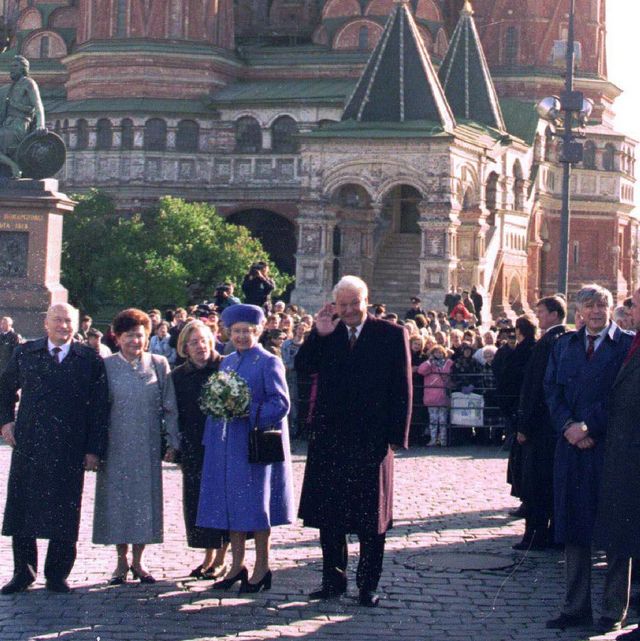
Here, see all the photos of Queen Elizabeth's 1994 trip to Russia, as shown on The Crown :
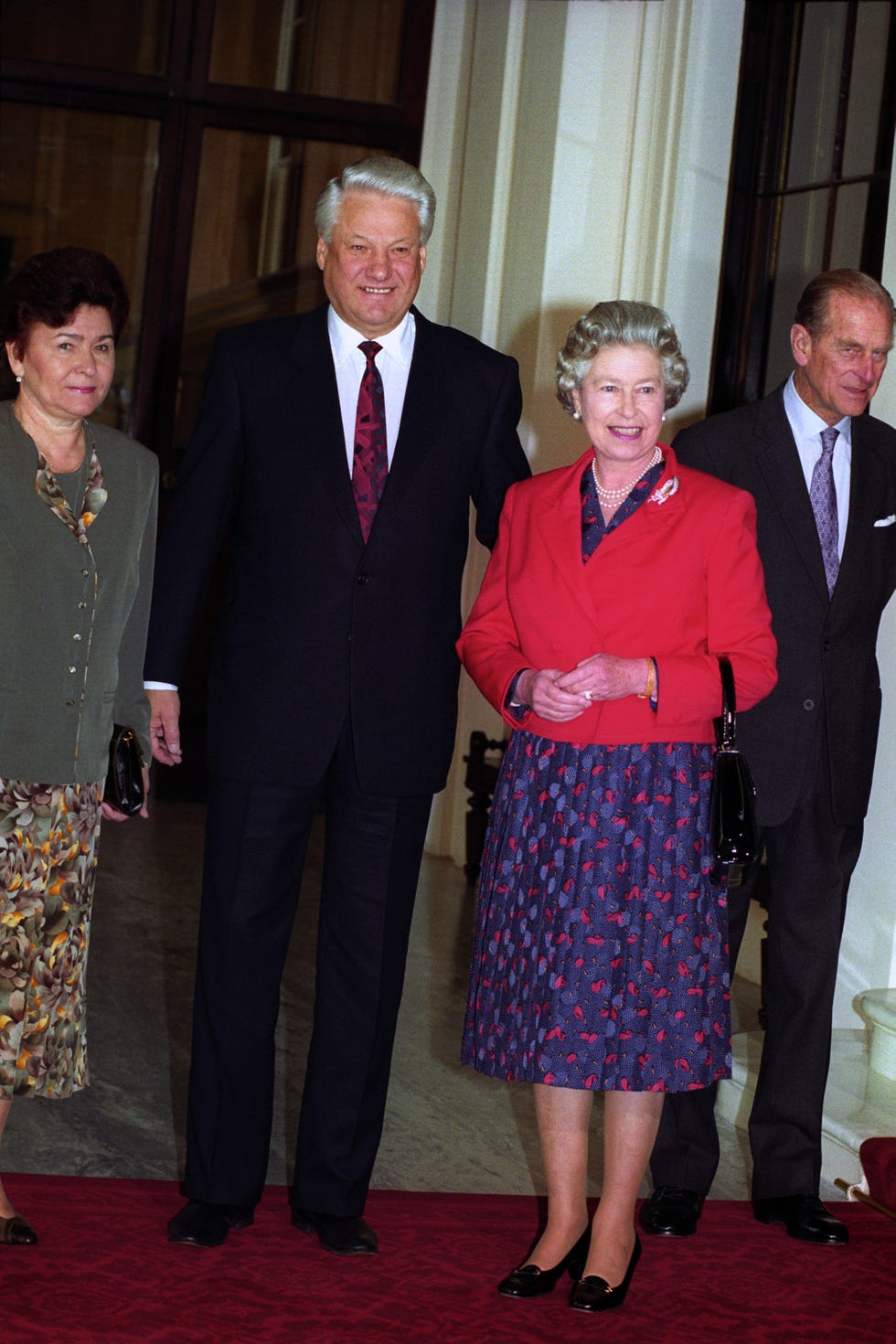
This is not from the State Visit to Russia, rather this is when Yeltsin visited the UK two years prior. Pictured are Naina Yeltsin, President Boris Yeltsin, Queen Elizabeth, and Prince Philip at Buckingham Palace.
State Visit, 1994
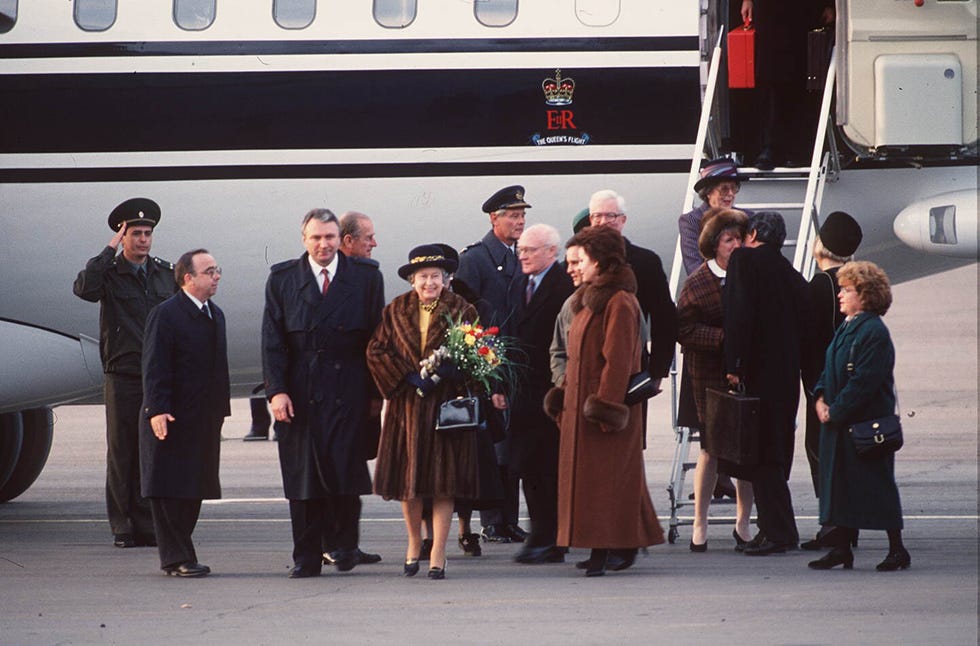
Queen Elizabeth is pictured arriving in Moscow, wearing a glamorous fur coat.
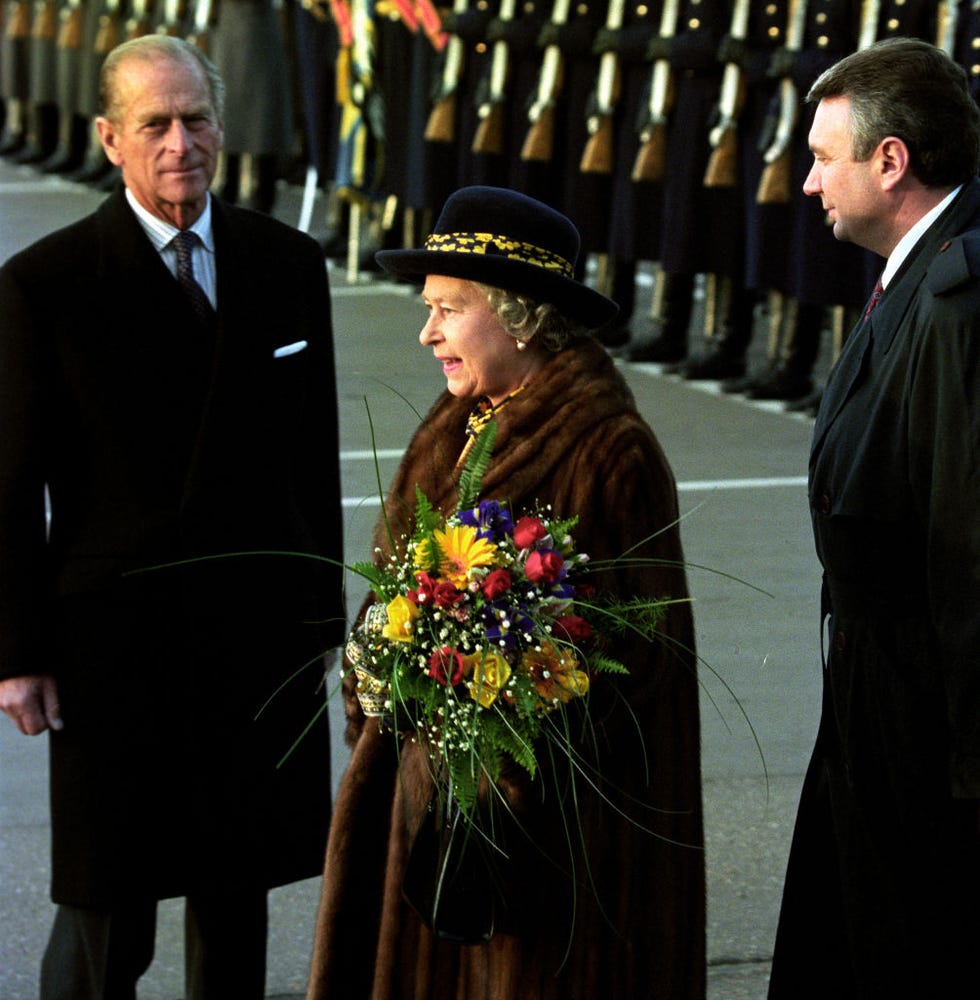
A close-up of the Queen and Prince Philip upon their arrival in Russia.
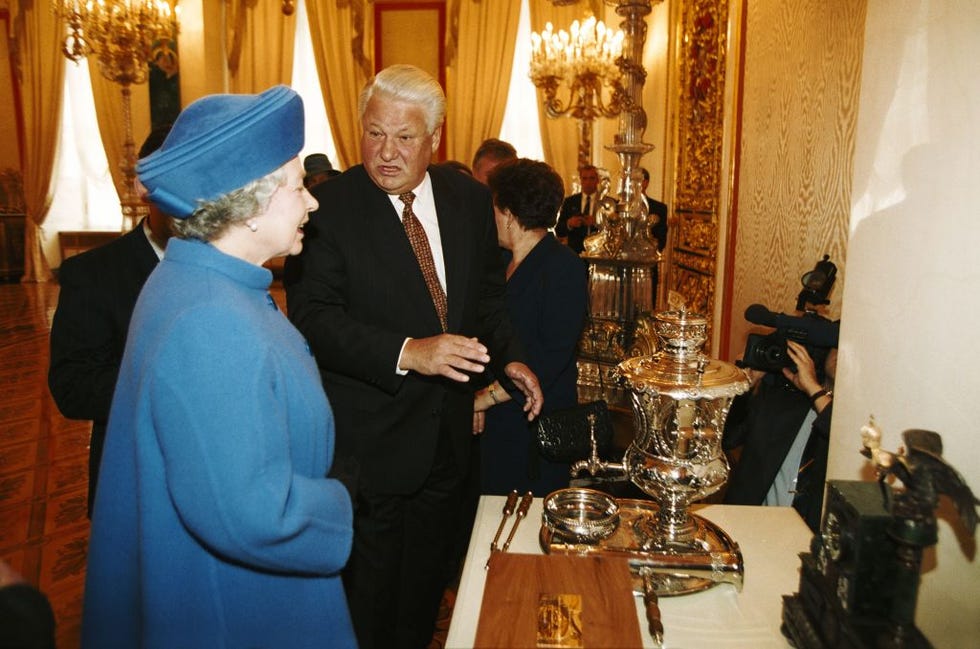
Throughout the trip, she was accompanied by Boris Yeltsin, who served as president of Russia from 1991 to 1999.
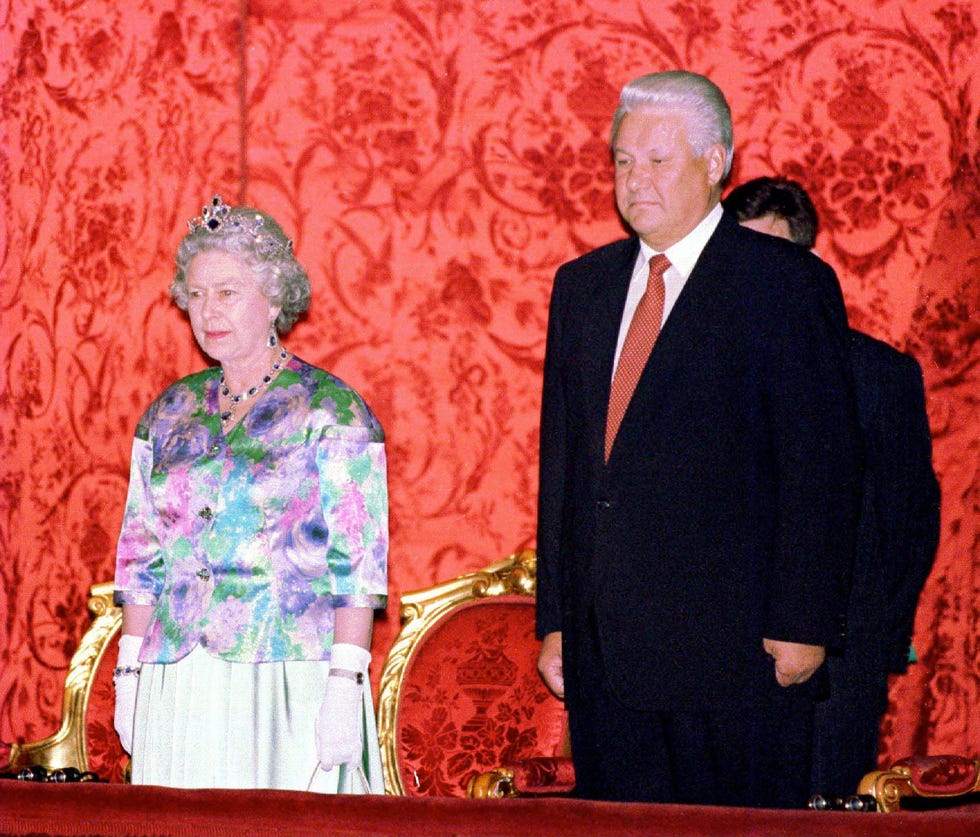
Queen Elizabeth was not the first British royal to visit Russia. In 1973, Prince Philip and Princess Anne attended a horse eventing competition in Kyiv, then part of the Soviet Union, and in 1994, Prince Charles visited Saint Petersburg.
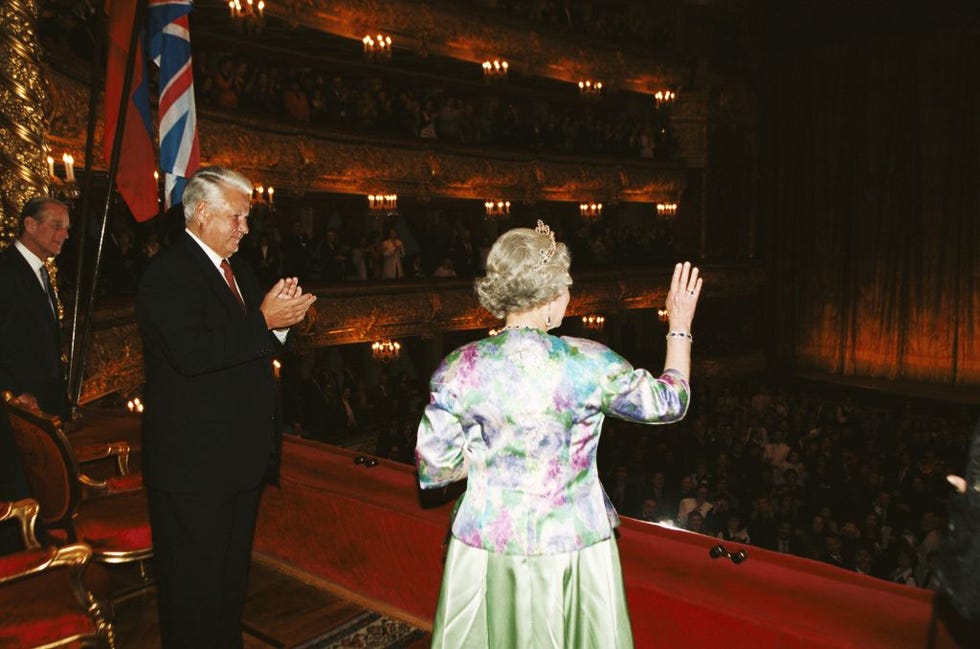
Queen Elizabeth and Prince Philip stayed in the Kremlin as guests of Yletsin.

Here, the Queen and Yetsin are pictured at the Bolshoi theatre.
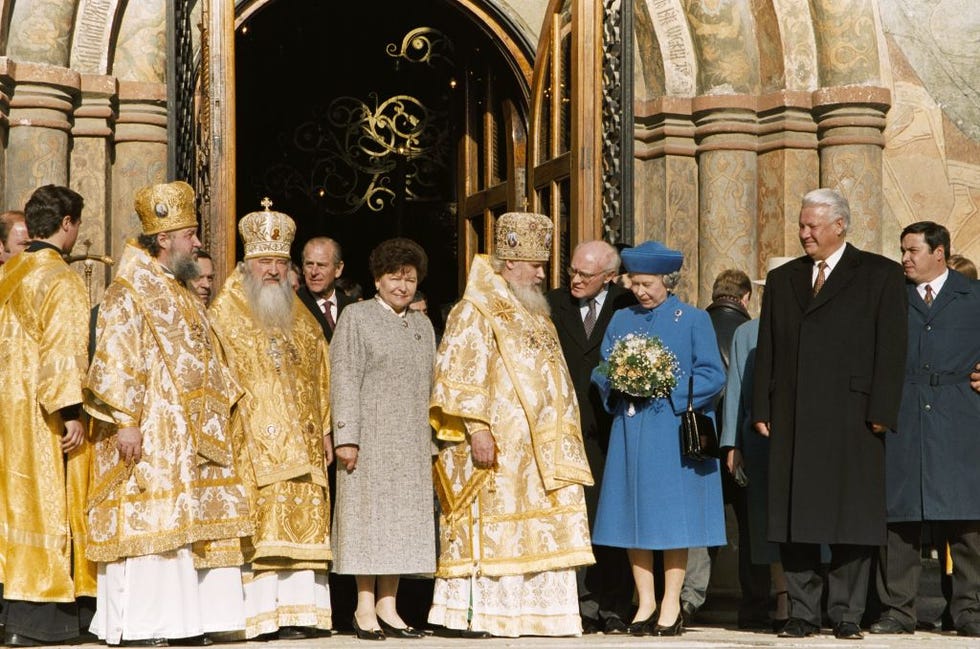
Queen Elizabeth met Patriarch Alexius II and mayor of Moscow Yury Luzhkov; they are pictured here outside Saint Basil's Cathedral.
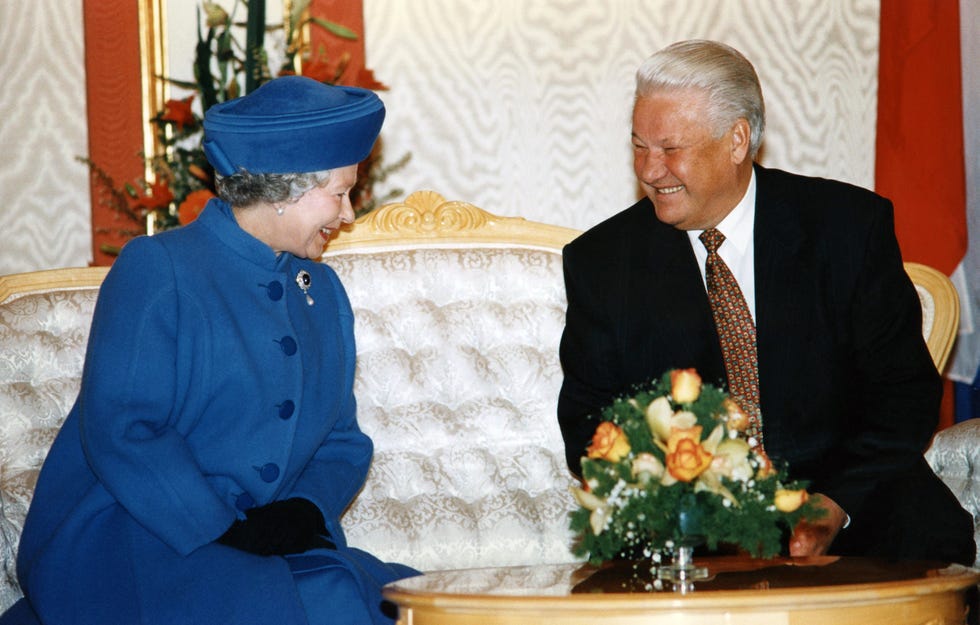
"For Russia, this visit is the utmost recognition that our country is on the road to democracy," Yeltsin told reporters of the Queen's visit.
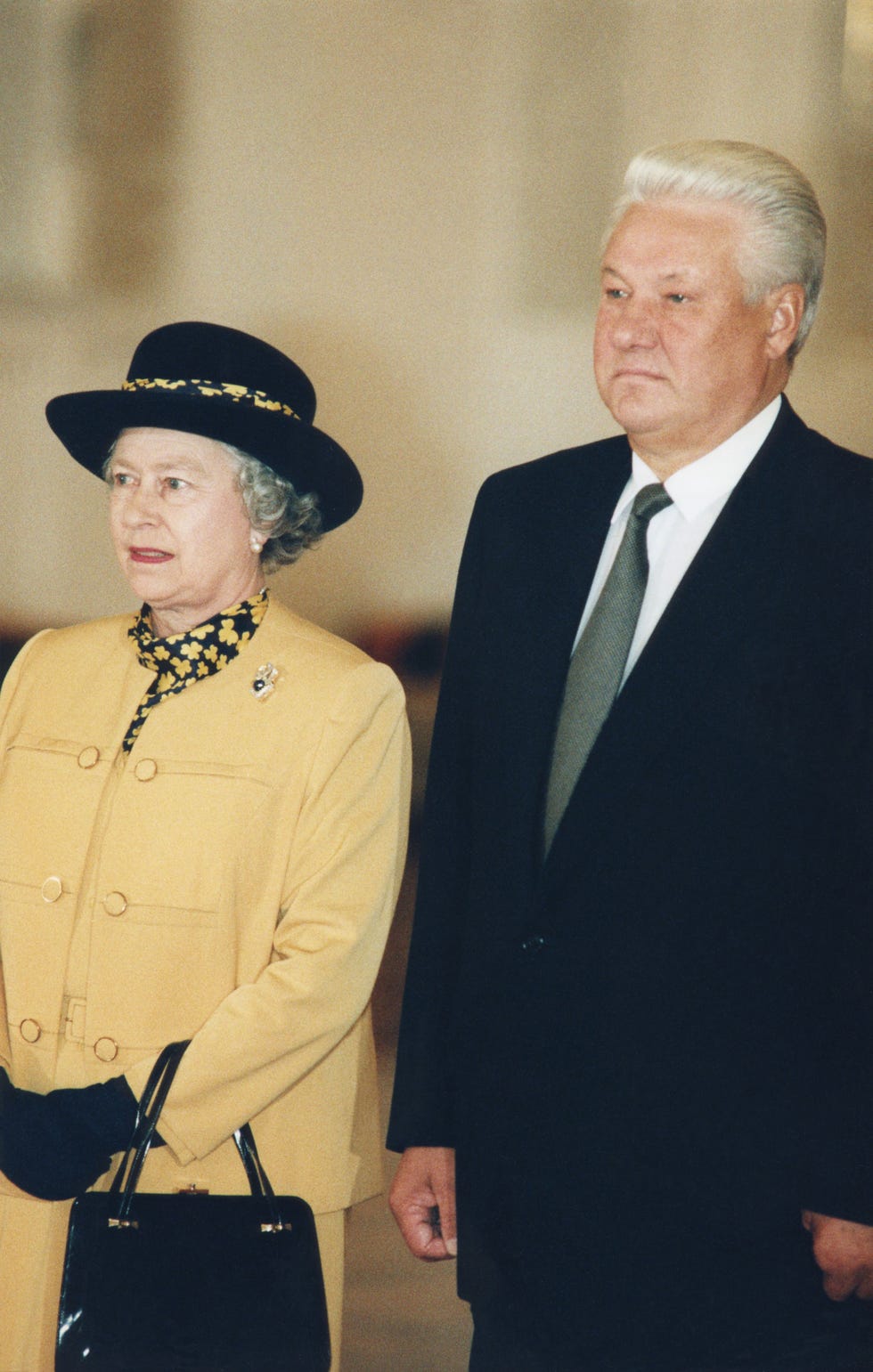
As The Crown shows, the murder of Tsar Nicholas II and his family was a reason why the Queen had yet to visit Russia. Her grandfather, King George V, was Nicholas's first cousin.
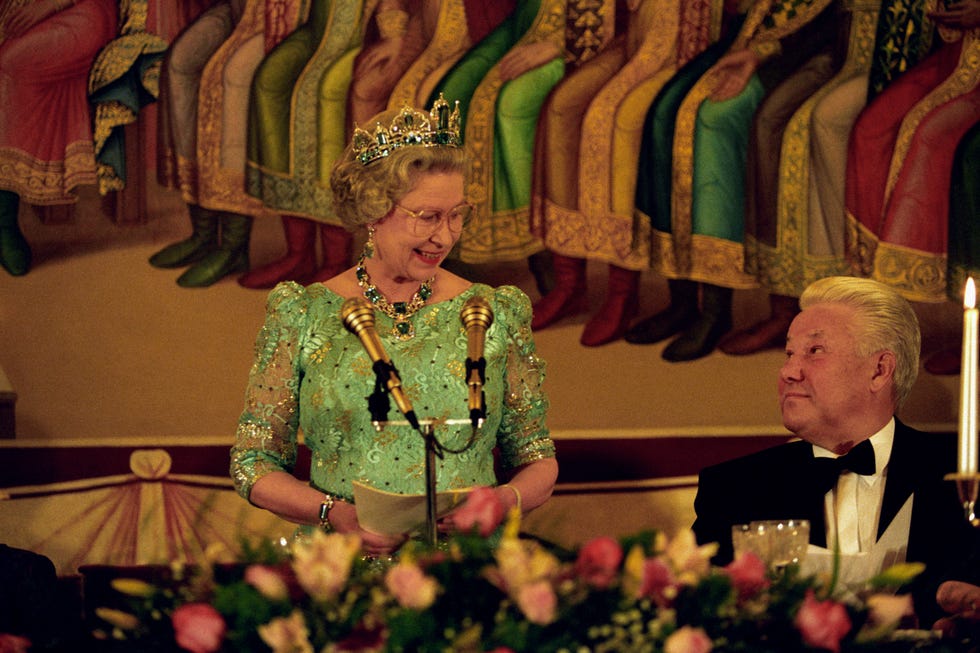
"You and I have spent most of our lives believing that this evening could never happen. I hope that you are as delighted as I am to be proved wrong," Queen Elizabeth said to Yeltsin at a state banquet.
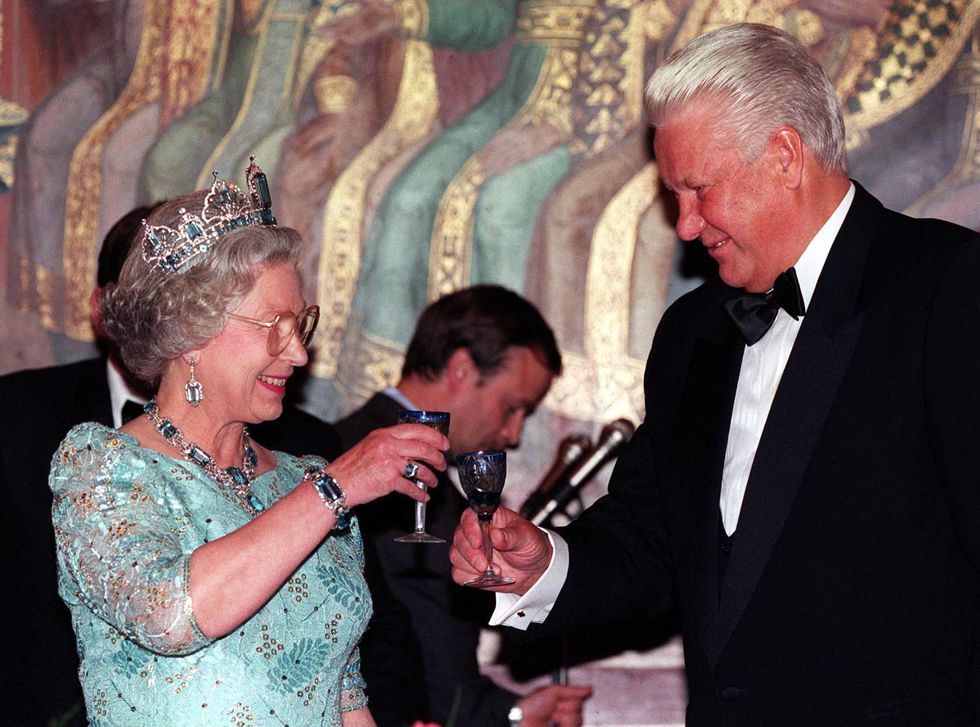
The two toasted at the banquet.
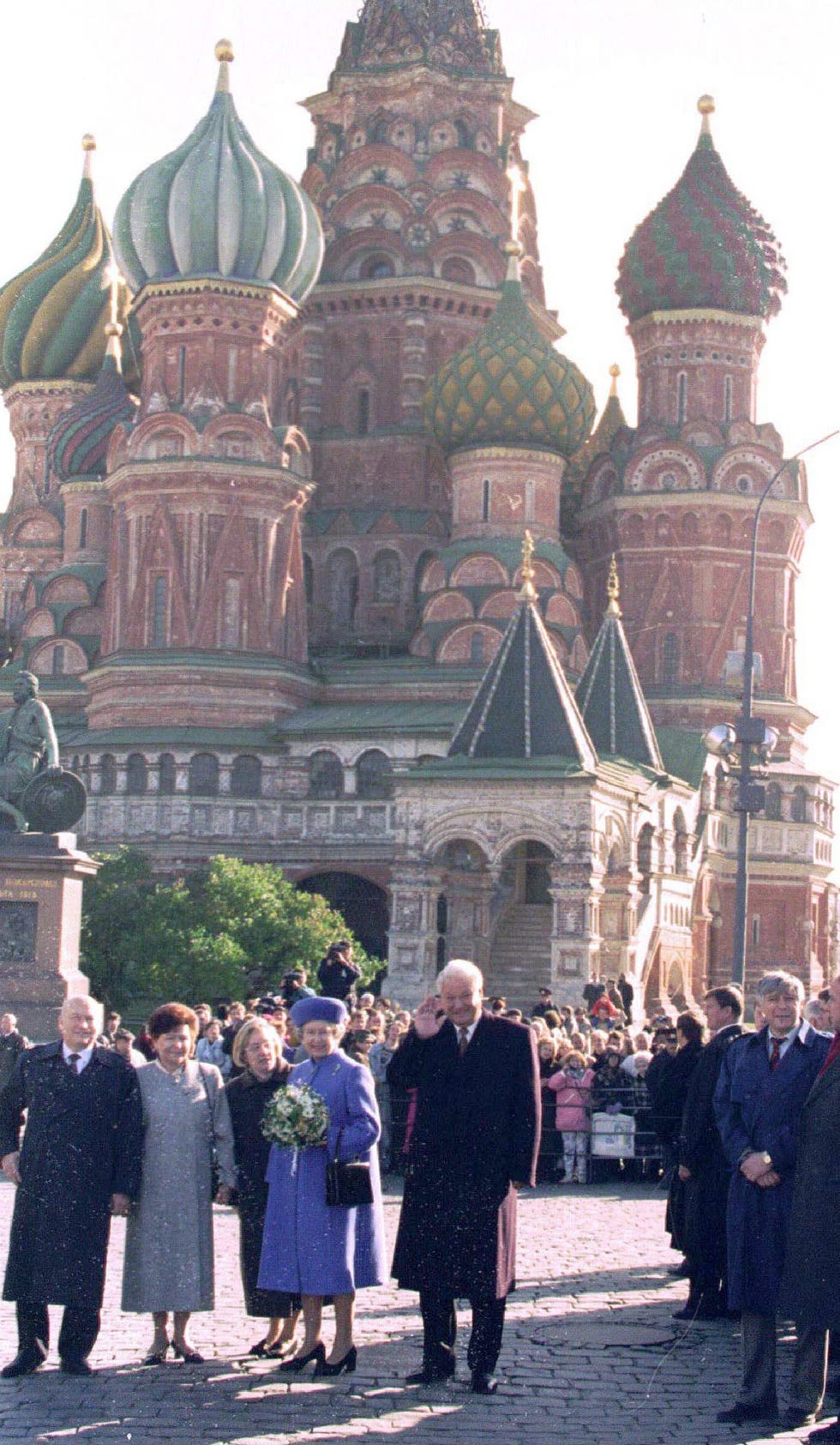
Queen Elizabeth toured Moscow during her four day trip, including visiting the famous Red Square.
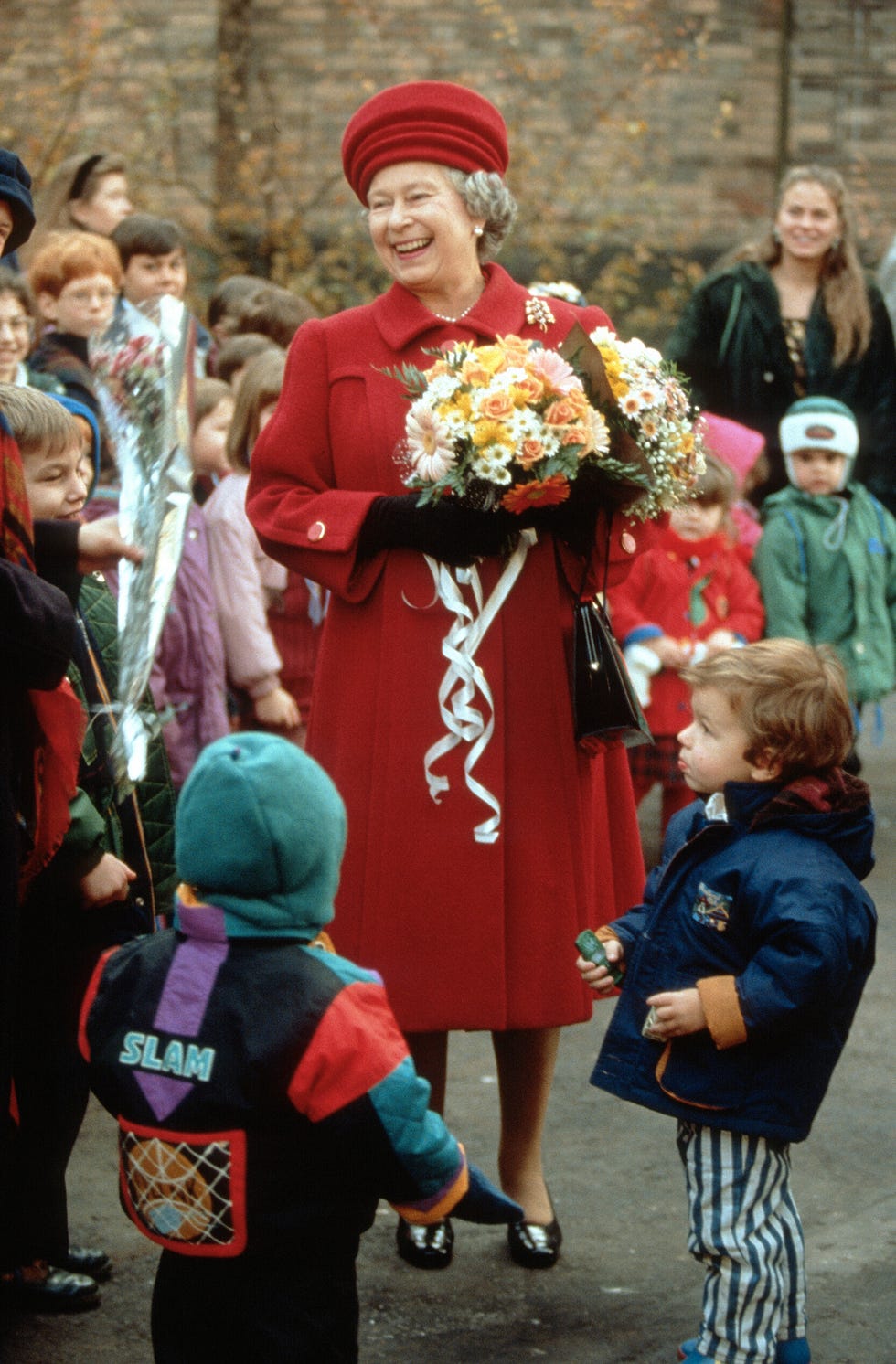
She also met Russian children.
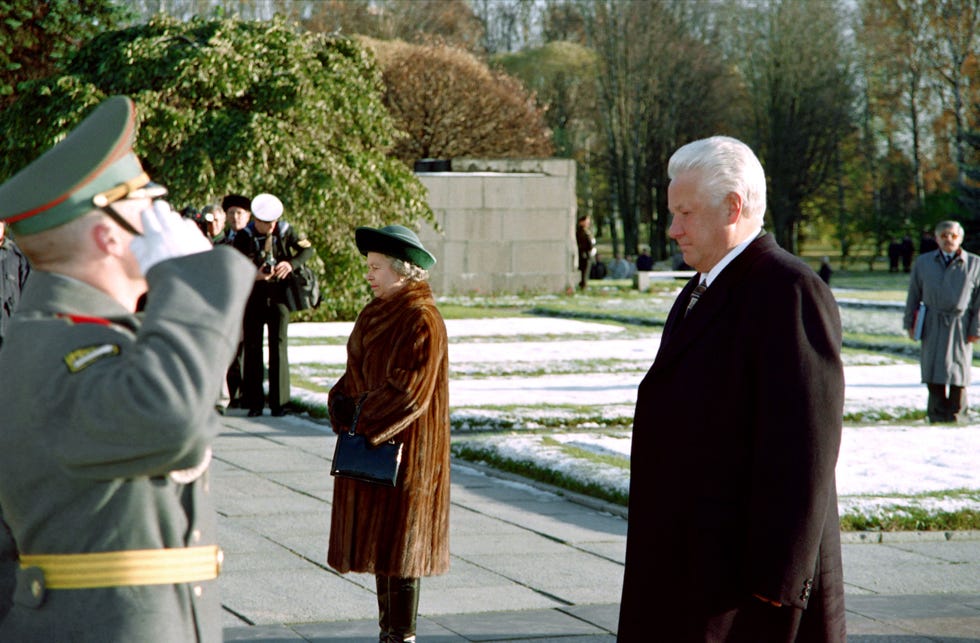
There were more formal events during the trip, too; Queen Elizabeth and Yeltsin attended a ceremony at the Piskarevskoye cemetery, a WWII memorial in St. Petersburg.
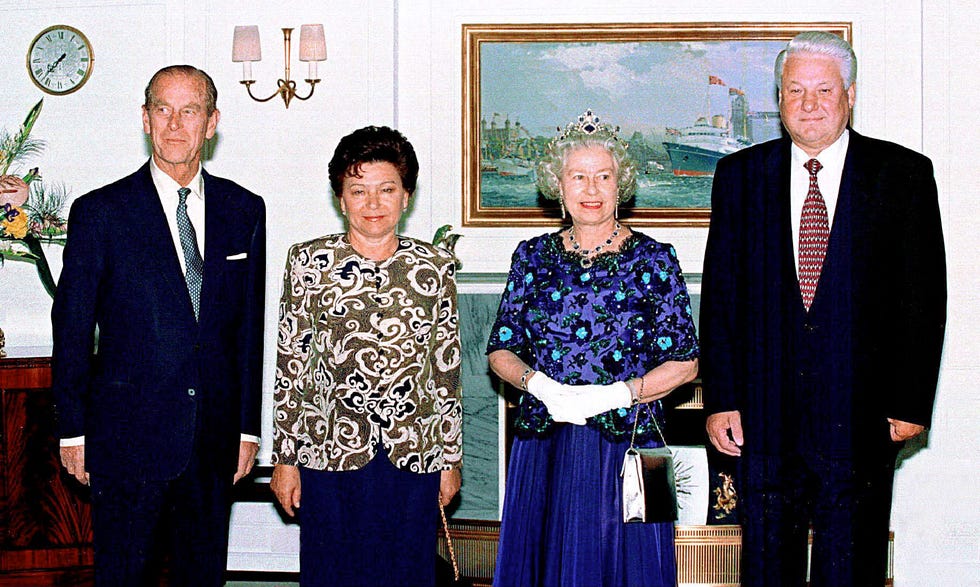
During the trip, Prince Philip and the Queen hosted the Yeltsins on board the Royal Yacht Britannia for a banquet.
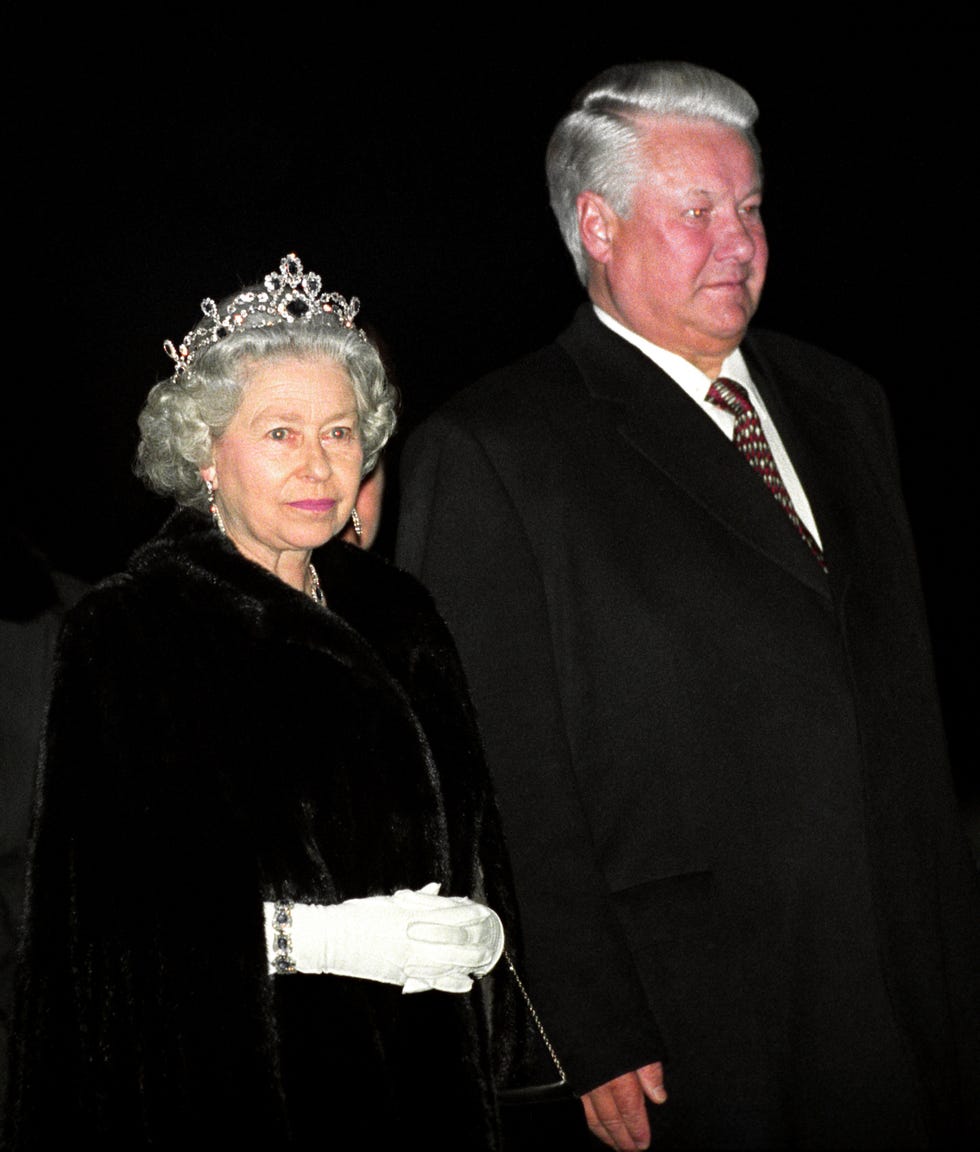
During her Christmas address two months later, Queen Elizabeth reflected, "I never thought it would be possible in my lifetime to join with the Patriarch of Moscow and his congregation in a service in that wonderful cathedral in the heart of the Moscow Kremlin."
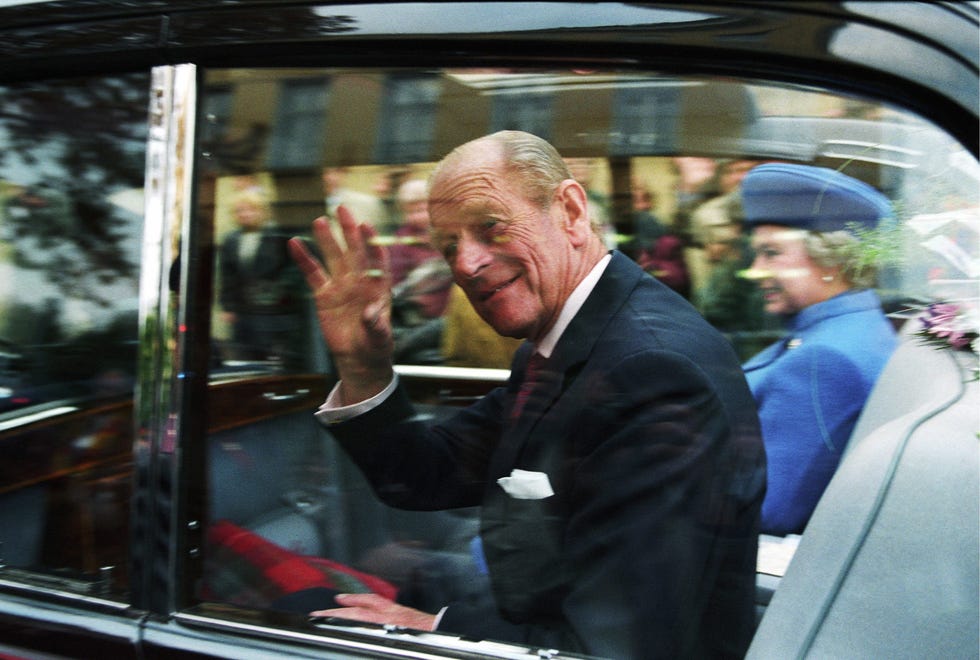
Queen Elizabeth would not return to Russia; Prince Philip returned once more, in 1995, as president of the World Wildlife Fund.
Emily Burack (she/her) is the Senior News Editor for Town & Country, where she covers entertainment, culture, the royals, and a range of other subjects. Before joining T&C, she was the deputy managing editor at Hey Alma , a Jewish culture site. Follow her @emburack on Twitter and Instagram .
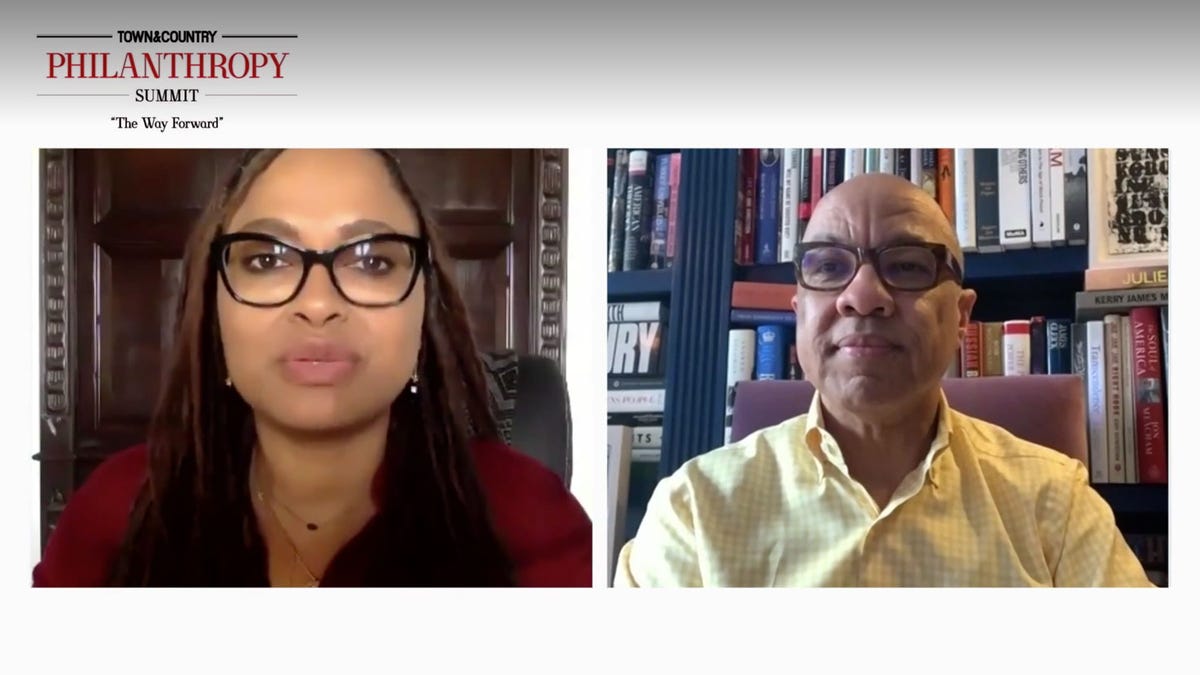
@media(min-width: 40.625rem){.css-1jdielu:before{margin:0.625rem 0.625rem 0;width:3.5rem;-webkit-filter:invert(17%) sepia(72%) saturate(710%) hue-rotate(181deg) brightness(97%) contrast(97%);filter:invert(17%) sepia(72%) saturate(710%) hue-rotate(181deg) brightness(97%) contrast(97%);height:1.5rem;content:'';display:inline-block;-webkit-transform:scale(-1, 1);-moz-transform:scale(-1, 1);-ms-transform:scale(-1, 1);transform:scale(-1, 1);background-repeat:no-repeat;}.loaded .css-1jdielu:before{background-image:url(/_assets/design-tokens/townandcountrymag/static/images/diamond-header-design-element.80fb60e.svg);}}@media(min-width: 64rem){.css-1jdielu:before{margin:0 0.625rem 0.25rem;}} The Crown @media(min-width: 40.625rem){.css-128xfoy:before{margin:0.625rem 0.625rem 0;width:3.5rem;-webkit-filter:invert(17%) sepia(72%) saturate(710%) hue-rotate(181deg) brightness(97%) contrast(97%);filter:invert(17%) sepia(72%) saturate(710%) hue-rotate(181deg) brightness(97%) contrast(97%);height:1.5rem;content:'';display:inline-block;background-repeat:no-repeat;}.loaded .css-128xfoy:before{background-image:url(/_assets/design-tokens/townandcountrymag/static/images/diamond-header-design-element.80fb60e.svg);}}@media(min-width: 64rem){.css-128xfoy:before{margin:0 0.625rem 0.25rem;}}
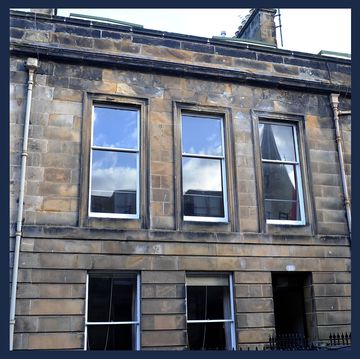
How Did Prince William and Kate Middleton Meet?
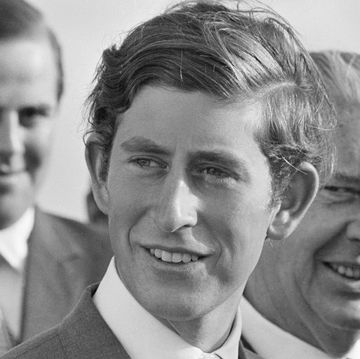
King Charles III's Life in Photos
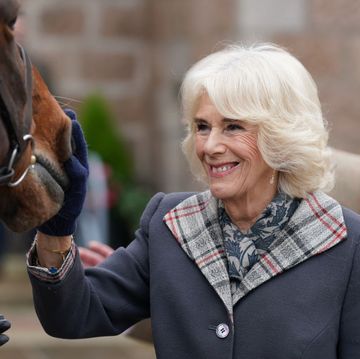
Queen Camilla's Life in Photos
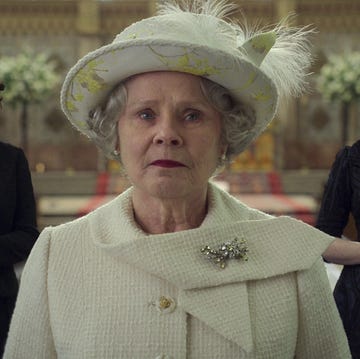
'The Crown' Leads BAFTA TV Nominations

Elizabeth Debicki Wins SAG Award
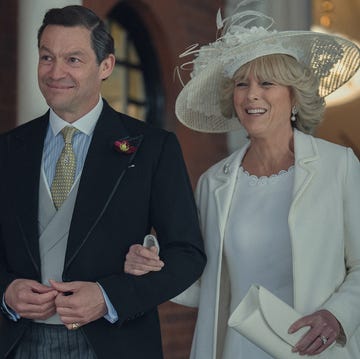
Dominic West Stayed in Bed After 'The Crown'
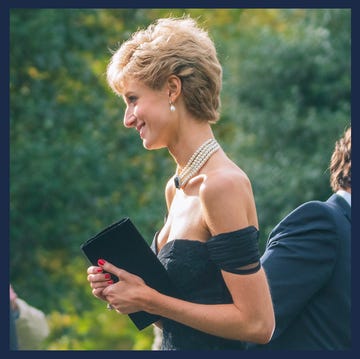
The Crown's Costumes, Props, and More at Auction

Elizabeth Debicki Stuns in Dior

Elizabeth Debicki's Best Red Carpet Looks

Elizabeth Debicki Wins Golden Globe

Jonathan Pryce Apologized to Princess Anne
- Destinations
- Things to Do
- Restaurants
- Art & Culture
- Music & Nightlife
- Los Angeles

Memories of the Queen’s visit to Croatia
Her Majesty, Queen Elizabeth II, only came to Croatia once but made a long-lasting impression on local citizens and dignitaries
Queen Elizabeth II only visited Croatia once, back in 1972, when the country was still part of Yugoslavia. Archive images show the Queen at the city’s main station, Glavni kolodvor, where she had arrived by train from the wine-producing centre of Đakovo.
Over the course of her five-day official visit, accompanied by her husband, Prince Philip and her daughter, Princess Anne, the Queen also went to Dubrovnik, Pula and the Brijuni islands.
In Zagreb, the Queen was greeted with an official ceremony at which the British, Yugoslav and Croatian anthems were played. She then toured the city in an open-top car and chatted with a couple of locals on her walkabout.
After an official dinner at governmental offices, the Queen went to the Croatian Academy of Arts and Sciences (HAZU), where she offered her positive impressions of Zagreb and Croatia in general, and made comparisons between the proud maritime heritage of Croatia and Great Britain.
Earlier this year, to mark the 70th anniversary of the occasion, HAZU reproduced details from the visit and the text of the Queen’s speech on that day.
- Time Out contributors
Share the story
Discover Time Out original video
- Work for Time Out
- Privacy policy
- Website terms of use
- Modern slavery statement
- Manage cookies
Time Out Croatia
- Advertising
- Editorial enquiries
Time Out products
- Mobile applications
- Time Out Global

Alexandra of Greece – The last Queen of Yugoslavia

If there is one word that could safely characterise the life of Queen Alexandra of Yugoslavia it would be “exile”. Even her birth happened in the margins of royal protocol and rules.
Her parents, King Alexander of Greece and Aspasia Manos, a commoner and daughter of a Greek colonel, fell in love in 1915 and got secretly engaged due to the expected refusal of the royal family to recognise the relationship of Alexander I with a woman who did not belong to one of the European ruling dynasties. Some sources even mention that they got married in 1919, despite strong opposition not only from the Greek royal family but also from the government in Athens who would have very much liked that their King married to a British princess.
Aspasia was pregnant when the King died suddenly following a monkey bite. Five months after his death, Alexandra was born, and the royal family agreed to be godparents of the little girl, who was baptised at the royal palace. Still, neither Alexandra nor Aspasia received official recognition: from a legal point of view, they were commoners without any rights in the royal family. Things changed in 1922 when the government passed a new law recognising the marriages of the members of the royal family with commoners. The little princess obtained the style of Royal Highness and the title of Princess of Greece and Denmark, although she had no right to inherit the throne.
The political situation in Greece went from bad to worse, and in 1924, Alexandra and her mother were forced to leave Greece and take the hard path of exile. They found refuge with Queen Sophia, Alexandra’s paternal grandmother in Italy. Alexandra spent some happy childhood vacations with her aunts, Crown Princess Helen of Romania, Princesses Irene and Katherine of Greece, and her cousins Prince Philip of Greece (the future Duke of Edinburgh) and Prince (later King) Michael of Romania, who became her playmates. Her friendship with the future husband of Queen Elisabeth would last a lifetime.
In 1927, Alexandra went to boarding school in England, and she hated the educational system to the point that when her mother refused to take her home, she stopped eating. The school doctor became worried about her health and advised Aspasia to take her daughter home. The girl contracted tuberculosis, and mother and daughter went to Switzerland for treatment.
Alexandra finished her studies in Paris, and she settled with her mother in Venice. The first marriage proposal came from King Zog of Albania who, according to palace sources, fell in love when seeing her photo. Alexandra’s mother thought her daughter was too young and was relieved when King George II of Greece refused permission for the match.
Like all women of her age and class, Alexandra participated at numerous receptions and events, which aimed to introduce her to the European elite. In 1937, she was presented in Paris, where she danced with her cousin, the Duke of Windsor, installed in France with Wallis Simpson since his abdication. There was also a rumour that she was briefly engaged to Philip (later Duke of Edinburgh). However, the one who would finally marry her was King Peter of Yugoslavia. Aspasia was delighted but less so was Peter’s mother, Queen Marie (formally Princess Maria of Romania). Her sharp opposition to the marriage would postpone the wedding for almost two years, and the two lovers would have only brief meetings in the London house of the Marina, Duchess of Kent, for all this period.

The couple finally married on 20 March 1944. The ceremony, at which the King’s mother refused to participate, was held at the Yugoslav embassy in London. The wedding was very well attended by no less than four reigning kings and queens and important members of the European royalty. Due to a difficult financial situation and war restrictions, the bride had to borrow a wedding dress from a relative.
Unfortunately, the marriage was not a happy one. Added to their financial hardships, both husband and wife’s inability to manage their budget and make wise decisions about their household led to bitter frustrations and continuous conflicts. King Peter turned to alcoholism and tried to forget his problems by conducting a number of affairs with younger women. Alexandra developed anorexia and a body dysmorphic disorder, which led her – according to sources – to undergo removal of the breasts because she was convinced that her husband didn’t like her chest. Increasingly unstable, she made her first suicide attempt during a visit to her mother in Venice in the summer of 1950. Another two unsuccessful suicide attempts were to follow in the years to come.
The couple had a son, Crown Prince Alexander of Yugoslavia who was born in London, in 1945, at the Claridge’s hotel. To enable the child to be born on Yugoslav soil, the British Prime Minister Winston Churchill reportedly asked King George VI to issue a decree transforming, for a day, Suite 212 at Claridge’s hotel into Yugoslav territory, which was to be the only time Alexandra was in Yugoslavia as queen. Her adopted country became a republic in the same year (1945).
Alexandra died in 1993, in London, following a painful battle with cancer. On 26 May 2013, her remains were transferred to Serbia for reburial in the crypt of the Royal Mausoleum at Oplenac, where the remains of other members of the Yugoslav royal family were also transferred.
Alexandra, Princess of Greece and Denmark, was the last queen of Yugoslavia. Her life was as tormented and difficult as that of the country she never had the chance to know and love.
Share this:
- Click to share on Twitter (Opens in new window)
- Click to share on Facebook (Opens in new window)
- Click to share on WhatsApp (Opens in new window)
- Click to share on LinkedIn (Opens in new window)
- Click to share on Reddit (Opens in new window)
- Click to share on Tumblr (Opens in new window)
- Click to share on Pinterest (Opens in new window)
- Click to share on Pocket (Opens in new window)
- Click to email a link to a friend (Opens in new window)
- Click to print (Opens in new window)
- Alexandra of Greece
Be the first to comment
Leave a reply cancel reply.
Your email address will not be published.
Yes, add me to your mailing list
Notify me of follow-up comments by email.
This site uses Akismet to reduce spam. Learn how your comment data is processed .
Copyright © 2024 | MH Magazine WordPress Theme by MH Themes
To provide the best experiences, we and our partners use technologies like cookies to store and/or access device information. Consenting to these technologies will allow us and our partners to process personal data such as browsing behavior or unique IDs on this site and show (non-) personalized ads. Not consenting or withdrawing consent, may adversely affect certain features and functions.
Click below to consent to the above or make granular choices. Your choices will be applied to this site only. You can change your settings at any time, including withdrawing your consent, by using the toggles on the Cookie Policy, or by clicking on the manage consent button at the bottom of the screen.
Subscribe to our free weekly newsletter and stay up to date on History of Royal Women's articles!
Not interested? Simply click 'close' in the top right corner to continue reading!
Check your inbox or spam folder to confirm your subscription.

- HM Queen Maria of Yugoslavia
- History of the Dynasty
- Djordje Petrovic, known as Karadjordje
- Jelena Petrovic
- HSH Prince Alexander of Serbia
- Princess Persida Karadjordjevic
- HM King Peter I of the Serbs, Croats and Slovenes
- Princess Zorka Karadjordjevic
- HM King Alexander I of Yugoslavia
- HRH Prince Paul of Yugoslavia (Regent)
- HM King Peter II of Yugoslavia
- HM Queen Alexandra of Yugoslavia
- Important historical documents
Lines of descent
Descent of Crown Prince Alexander from Karageorge
Descent of Crown Prince Alexander from Kings of England, Great Britain and United Kingdom and from the Reigning Dukes of Sachsen-Coburg-Gotha
Descent of Crown Prince Alexander from the Danish and Greek Royal Families
Descent of Crown Prince Alexander from the Russian Emperors
Descent of Crown Prince Alexander from the Petrovic-Njegos Royal Family

HM Queen Maria was the daughter of HM King Ferdinand of Romania and HM Queen Marie of Romania (a daughter of HRH Prince Alfred, Duke of Edinburgh, a son of Queen Victoria of the United Kingdom). The Queen was born in Gotha, Thuringia, Germany 9 January 1900 and died in London 22 June 1961. Her Majesty married HM King Alexander I of Yugoslavia in Belgrade 8 June 1922 and they had three sons Crown Prince Peter (later HM King Peter II , father of HRH Crown Prince Alexander II ), Prince Tomislav and Prince Andrej.
She was loved very much by Serbian people. She was a role model of a devoted and caring wife and mother. She was very much engaged in humanitarian work. After the assassination of HM King Alexander I in Marseilles 9 October 1934 she continued to care for her sons and became the Queen Mother. She was very active with the Red Cross during World War II, and sent a lot of humanitarian help to Yugoslavia, but always signed herself with the alias Maria K. Djordjevic.
She lived modestly on her estate in Kent, England after World War II. General Charles de Gaulle decorated her with the Great Cross of the Legion of Honour in 1959. She passed away on 22 June 1961 in London, and was buried at the Royal Cemetery in Frogmore in Windsor. Her remains were transferred to Serbia on 29 April 2013, and she was buried at the Royal Mausoleum in Oplenac during the State funeral 26 May 2013.
Share this article:
- Jan 23, 2020
- 14 min read
14 Places to Time-Travel back to Yugoslavia
Updated: Apr 19, 2020
If you have a desire to experience of the history, design, style and aesthetics of the former Yugoslavia, then these destinations are for you!

As global tourism to the region of the former Yugoslavia has been increasing over the last few years, as well as interest in the former country’s history, art and architecture (as well as the concept of Yugo-tourism itself), I thought it would be fun to compile a list of places across that region where one can visit to learn about and experience a taste of Yugoslavia. In the decades since the onset of Yugoslavia’s dismantling in the early 1990s and the formation of new independent nations, many reminders of that former nation have vanished. Much of this vanishing has been a natural result of the unsurprising change in fashions, styles and trends from the 70s/80s Yugoslav-era to today (much like the rest of the world has advanced from that era with their fashions and styles). However, on top of just the changing of styles, in many places in the former republics, much effort was made towards actively erasing any reminders of the Yugoslav state all together, including the tearing down of statues/monuments, the changing of street names, the demolishing of buildings, and the removal of any other such types of symbols that might speak of Yugoslavia.
Yet, there are a few places still within the former Yugoslav republics where you can still find glimpses of that era (both stylistically and culturally) through museums, time-capsule-like locations and re-creations which continue to preserve and present the distinct atmosphere and energy which that former country exuded. This list will include not only the traditional and expected museums, but also historical sites, shops, cafes, accommodations, and other unique touristic sites that operate as enigmatic portals to a time long past and a country that no longer exists.
1.) The Museum of Yugoslavia, Belgrade, Serbia

Located in the Dedinje neighborhood of Belgrade is the Museum of Yugoslavia. Built next to Yugoslav President Josip Broz Tito’s official Belgrade residence, the original name for the museum (until 1996) was the “Josip Broz Tito Memorial Center”. During the Yugoslav-era it was one of the central locations where Tito’s birthday, dubbed Youth Day, was celebrated each year on May 25th. Youth Day was characterized by a nationwide children’s relay race which concluded just across the street from the museum at Partizan Stadium. Every year, children from across Yugoslavia would send Tito home-made batons in hopes that it would be the one chosen for use in that year’s relay race. In 1962, the first museum building was opened to display all of the many children’s batons sent to Tito, as well as to serve as a display location for the many gifts given to Tito by national leaders from around the world. A few years later, a new building was added to the complex called the May 25th Museum, which allowed further exhibition space. Then, in 1975, the House of Flowers was built next to these two museum buildings to act as a winter garden for Tito and his wife Jovanka.
However, upon Tito’s death in 1980, the House of Flowers was used as his final resting place. Many of the original stylings, architecture and aesthetics of the three buildings of the Museum of Yugoslavia have been preserved over the decades, acting as a unique window into the time period. The official website for the Museum of Yugoslavia can be found at THIS link .
2.) The Red History Museum, Dubrovnik, Croatia

Situated in the ancient Adriatic city of Dubrovnik, Croatia is the Red History Museum. Opened less than a year ago in April of 2019, this new museum contains thousands of exhibits related to all facets of life in the former Yugoslavia, from cars, to music, to politics, to home-goods, to pop-culture, and much more. Not only is the museum arranged with traditional museum exhibits (showing history time-lines, vintage photos, maps, etc), but there are also several areas with period furniture set up to resemble an authentic Yugoslav-era apartment, which include even the smallest details of appliances, magazines, cigarettes and more. Through these lengths to put on display accurate representations of the past, the Red History Museum is able to display to visitors what normal every-day life would have been like for citizens during the Yugoslav-era. Furthermore, the museum takes Yugoslav-era artifact presentation even further by bringing in a bright red beautifully restored Yugo car into the museum’s entrance area, while the ticket booth for the museum is a shining silver K-67 kiosk (both of which will no doubt bright back countless personal memories for anyone who grew up in Yugoslavia). The museum also includes space for various temporary exhibitions, as well as a clever gift shop for anyone wanting to take away a momento. The official website for the Red History Museum can be found at THIS link .
3.) Caffe Tito, Sarajevo, Bosnia & Herzegovina

Tucked behind Sarajevo’s Historic Museum of Bosnia and Herzegovina is the popular student hot-spot known as Caffe Tito. Set up as a tribute established to President Josip Broz Tito, this relaxed cafe is decorated with a fascinating variety of Yugoslav-era memorabilia, vintage photos, old newspaper clippings, old WWII-era military equipment and banners bearing Partisan mottos, such as the famous “ smrt fašizmu, sloboda narodu ” or “ death to fascism, freedom to the people ”. Also inside Caffe Tito, which is unsurprisingly painted in a red theme, you can even find a large bronze sculptural bust of Tito, based off of the well-known Tito sculpture by Antun Augustinčić. Altogether, the cafe almost verges on feeling like a time-capsule museum in the way that it has curated its playful collection of history, style and nostalgia. Meanwhile, the cafe has a beautiful outdoor beer garden to relax with your drink for enjoying the Sarajevo ambiance and the establishment’s hipsterish youthful atmosphere.
4.) Guesthouse Yugodom, Belgrade, Serbia

Nestled in the cute Dorćol neighborhood of Belgrade’s old town is “ Yugodom ”, an apartment which has outfitted itself to exude the impression as if you have just stepped off of a time-machine into the ‘Golden Era’ of 1960s/70s era Yugoslavia. Bedecked with elegant period furniture, vibrant wallpaper, retro appliances, and everything else you could imagine to set the nostalgic scene, the Yugodom exists not only as a museum-like experience to absorb Yugoslav design aesthetics, but it is also a guesthouse, billing itself as a " Stay Over Museum ”, where you can book rooms for the night in order to properly take in the whole transportative experience. Its two bedrooms are expertly decorated, with one organized as a “ 60s themed ” room and the second a “ 70s themed ”, while the living room gives off more of an 80s vibe. Started in 2013 by young Belgrade interior designer Mario Milaković, this unique accommodation is one-of-a-kind in Belgrade, offering a type of experience that attracts not only tourists from around the world, but also people living within the former Yugoslav republics who want to dwell for a bit in the memories from the Yugoslav “Golden Era”. The official website for the Yugodom can be found at THIS link .
5.) Tito’s Bunker (ARK D-0), Konjic, Bosnia & Herzegovina

Hidden within an unassuming building within the steep slopes of Bjelašnica Mountain along the Neretva river valley, just southeast of the town of Kojnic, Bosnia, is the entrance to the underground Atomska Ratna Komanda (or “Atomic War Command” in English), otherwise known more shortly as ARK D-0 or simply Tito’s Bunker. This secret subterranean nuclear command center and protective bunker, which contains over 100 rooms cover almost 7,000 sq m, was built into Bjelašnica Mountain during the Cold War era to house the Yugoslav political elite in case of an attack. Meant to sustain a 20 kiloton nuclear blast, this underground complex was constructed over the course of nearly 15 years, starting in 1953. While Tito nor the country of Yugoslavia ever required its services, it was nonetheless always kept on standby at all times just in case disaster struck. However, as Yugoslavia began to be dismantled and the Bosnian War began in ramped up in the early 1990s, the bunker instead became a strategic military location during the war for re-supplying and as a medical base.
However, even despite the war, the bunker was largely kept in pristine condition. After the war, the new government of the newly independent Bosnia kept the existence of the bunker hidden from the general public. It was not until 2007 that existence of the bunker was made public and plans were released that it was to be turned into a public museum and gallery space. Opened in 2011 to the public for the first time, the bunker continues to retain much of its original Yugoslav-era military technology and equipment, as well as its furnishings and Tito’s private quarters. In addition, art exhibits are scattered around the huge complex from both regional and international artists. This unique Yugoslav time-capsule and one-of-a-kind art gallery is among the most singular museum experiences in Bosnia. For information about tickets, visit the Kojnic tourist website at THIS link .
6.) Tito’s Blue Train, Belgrade, Serbia

During the Yugoslav-era, when President Josip Broz Tito wished to ride the rails across his nation, his means to do so was via his own personal luxury train. The train’s exterior was painted in a distinct shade of blue (even the locomotives), while the train’s interior was lined in elegant wood panels, expensive furniture, fine curtains, modernist artwork and beautiful carpets, all gleaming with the uniquely Yugoslav design aesthetic that one would expect from a train meant to represent a country. Tito was not the only notable individual to ride upon this train, he also routinely hosted upon it many visiting dignitaries during their visits to Yugoslavia, such as François Mitterrand, Yasser Arafat, Jawaharlal Nehru, and Queen Elizabeth II, just to name a few. When Tito passed away in 1980 in Ljubljana, the train was used to carry his remains in a procession of mourning back to Belgrade, during which thousands of people came to watch the train pass to pay their last respects. Today the train exists much in the same condition and state as it did during the Yugoslav-era, with it sitting idle as a museum object trapped in time. However, every once in awhile, the train has been used for public touristic excursions to Montenegro, but today it sits at a train garage at Topčider in Belgrade where it is open to tours. You should be able to buy tickets for the Blue Train (Plavi voz) at either the central Belgrade train station or at Topčider station. Then take the tickets to the train garage across the street from the Rasadnik stop on Tram #3 [ coordinates ].
7.) The Zagreb 80s Museum, Zagreb, Croatia

Just a block north of Jelačić Square in the center of the city of Zagreb, Croatia is the “Zagreb 80s Museum”. Set up in a traditional Zagreb apartment is a unique museum that has re-created a 1980s Yugoslav-era style with exacting precision. This fully interactive museum lets you explore the space at your pleasure by allowing you to interact with the exhibits and explore the environment as if the apartment was your very own. Feel free to jam out on the record player with Yugoslav rock albums, test your skills at the Atari video game consoles set up to play, do some typing on the beautiful vintage typewriter on display, enjoy playing dress up in some vintage wardrobes, or even search through the cabinets of the museums faithfully preserved and presented kitchen. And on top of all of this, the museum also has a bright yellow restored Zastava 750 car on exhibit which you can explore. The Zagreb 80s Museum is most certainly like no other museum in Zagreb and operates as fantastic portal to those reminiscing of the Yugoslav era, or simply those who want to have a glimpse of it for the first time. The official website for the museum can be found at THIS link .
8.) Hotel Mladost, Tjentište, Bosnia & Herzegovina

If you are ever travelling high into the Zelengora Mountains to the beautiful peaks and alpine forests of Sutjeska National Park, the prime accommodation within the park is a spectacular destination called Hotel Mladost, nestled deep in the park’s pristine valley. Built in the 1970s, this fantastic hotel, which provides amazing views of the surrounding mountains and meadows, is a unique synthesis of rustic mountain lodge and Yugoslav modernist architecture, giving the space a distinct retro vibe and appearance. The rooms of the hotel are uniquely designed and furnished, and while they don’t necessarily have their original furniture or mid-century furniture, the hotel still acts as an effective means of transporting you to another era through its adventurous design and aesthetics. In addition, the whole Sutjeska National Park complex around the hotel, also developed during the 1970s mostly, also contains the same fashion of stylistic trends and features present in the hotel. And of course, a MUST see is the amazing Sutjeska monument just right next door to the hotel. For more information about staying at Hotel Mladost, as well as more info about Sutjeska National Park, check out THIS link to their official website.
9.) The Re-Use Center, Ormož, Slovenia

Situated in the small Eastern Slovenian village of Ormož is a modest second-hand shop called the “Re-Use Center” (Center Ponovne Uporabe). While this seemingly average shop filled with used clothes, knick-knacks, children’s toys and other sundry items might appear unremarkable at first, the surprise of this place is found in the upper level of the shop, where you will find an apartment set up as a time-capsule to the past. Dedicated to the 1970s/80s era Yugoslav design aesthetic, this apartment was recently decorated by the members of the second-hand shop as a place for people to experience the past. Explore their vast collection of vintage dishware, kick back in a fantastically modernist mid-century upholstered sofa, gaze at the streamlined beauty of their elegant Iskra phones and enjoy drooling over their assortment of classic Yugoslav-era candies and liquors. Anyone who grew up during this era will be instantly transported through time the moment they pass into this set of magically decorated rooms, while those who didn’t themselves live through this era will be captivated by the apartment’s warmth and allure. The apartment museum space is free and open daily during the normal business hours of the Re-Use Center. For more information, check out the shop’s official Facebook page at THIS link .
10.) The Sava Center, Belgrade, Serbia

Among the most ambitious and architecturally imaginative civic buildings created during the Yugoslav-era was the Sava Center in New Belgrade, Serbia. Designed by architect Stojan Maksimović and built in several stages between 1976 and 1979, this massive event center and shopping complex was conceived in 1975 after Tito offered Yugoslavia up to host the second annual OSCE international conference. The result was an amazing structure of glass walls, textured concrete, polished metal and exposed utilities that look futuristic both inside and out. This huge multi-level space soars and impresses, possibly being one of the most innovative and striking examples of 70s era Yugoslav architecture in Belgrade, if not all the former Yugoslavia. When walking through the shopping center section of the Sava Center, one gets the feeling they are walking through a spaceship more than exploring a retail space. Having changed little since its construction, the Sava Center continues to exude the classic 70s Yugoslav aesthetic, while giving visitors a fascinating view of the height of the country’s architectural achievements and interior design innovations. A MUST visit here is the beautiful long-bar found at the north end of the ground floor. Stop and get a drink and absorb the scenery! The official website for the Sava Center can be found at THIS link .
11.) MEMO Museum, Pula, Croatia

Located near the The Park of King Peter Krešimir in the Istrian town of Pula, Croatia is the MEMO Museum, which dubs itself as the “ Museum of Good Memories ”. Opened not that long ago in 2018 by the Institut Mediterran cultural group, this novel museum allows visitors to learn about how daily life was experienced in Pula during the booming ‘Golden Era’ of Yugoslavia. Exhibits here are dedicated to each of the decades between the 50s and the 80s, while also being split up into sections which show off street scenes, town square scenes, and apartment life. As you explore the exhibits at the MEMO Museum, you also have the ability to interact with them all as well. Feel free to jump inside of their yellow Zastava 750, play some Yugoslav rock records, sit under the hairdresser's "hauba", or pound on the vintage 80s computer games. In addition, the museum also hosts and provides educational workshops for those looking to learn more about the music, interior design, sports, history, etc of the Pula during the Yugoslav-era. The official website for the MEMO Museum can be found at THIS link .
12.) Hotel Jugoslavija, Belgrade, Serbia

Situated along the Danube River of New Belgrade, Serbia is the famous Hotel Jugoslavija. Built as the first true ‘luxury’ hotel in the country under an architectural design team led by Lavoslav Horvat, this stunningly huge complex existed as a modern cultural icon during the Yugoslav era (taking almost two decades to create), while, during its hay-day, it hosted innumerable celebrities and dignitaries from around the world as they passed through the country’s capital city. Not only was the hotel renowned for its architecture and distinct Yugoslav-style of mid-century interior design, but inside it also boasted one of the largest chandeliers in the world. The hotel was struck by NATO bombs in May of 1999 and was later closed after privatization in 2006. It subsequently re-opened to the public in the early 2010s. While some of the hotel, such as the lobby, has been renovated and stripped of its original Yugoslav-era furnishings and design, many of the hotel rooms and the elegant ballroom still retain a great deal of their original Yugoslav charm and aesthetics. A stay at the Hotel Jugoslavija is a MUST for anyone who is a Yugo-enthusiast or interested in the region’s architectural or design heritage. The official website for the hotel can be found at THIS link .
13.) Vila Galeb, Herceg Novi, Montenegro

Just west of the city center of the ancient Adriatic town of Herceg Novi there sits a beautiful stately home right on the waterfront called “Vila Galeb”. Today it is part of the Igalo Institute complex, but during the Yugoslav era, it was one of President Josip Broz Tito’s many summer retreat getaways. This opulent 5,600 sq m villa, built in 1976 by local architect Milorad Petijević and bedecked in high luxury and style, was built for Tito as a place for him to stay during his visits to the Dr. Simo Milošević Institute here in Herceg Novi (which is right next door), as it was among the best medical rehabilitation facilities in Yugoslavia. Being that this villa was built for Tito’s medical retreats, the home is fixed with wide array of then-cutting-edge rehab offerings, such as mineral baths, mud tubs, jet pools, and other various therapy devices. While here, Tito also hosted dignitaries from around the world, such as Safia Gaddafi, Prince Charles, Helmut Schmidt, among others. After Tito passed away in 1980, the residence sat idle for many years, only occasionally being rented out by high class clients. As such, the Vila Galeb remained in much the same condition as when it was built in the 1970s. Finally, in 2014, this long closed and guarded time-capsule residence began to be opened to guided tours for the public for the first time, offering a rare experience of one of President Tito’s personal homes in such a preserved state. For info on guided tours of Vila Galeb, more can be found at THIS link to the official Herceg Novi tourist website.
14.) Villa Kumrovec

Josip Broz Tito, the lifelong president of Yugoslavia, was born in the small Croatian town of Kumrovec. He took on the role of president of the country after leading the Partisan resistance forces to victory against the fascist Axis forces and their collaborators during WWII, at which point Tito’s Kumrovec homestead was turned into a museum complex. Tito still enjoyed spending time in his youthful stomping ground, as such, he had a recently built hotel there Kumrovec converted into a personal residence for himself. The building itself is of a traditional style of local vernacular architecture designed by Branko Bon in 1948, but it was renovated in 1962 in order to accommodate Tito’s living needs, at which point the interior of the home was decorated in an impressive mid-century style, standing in unique contrast to its exterior. After the dismantling of Yugoslavia, the home was left vacant for many years, with all of Tito’s possessions and personal items left relatively untouched and in place. It was not until 2015 that the Villa Kumrovec was finally opened up to the public for tours. These tours present visitors with a unique glimpse into Tito’s life, as well as a preserved snapshot of the stylistic trends of the Yugoslav-era. Information about visiting the various Tito-themed attractions here at Kumrovec can be found at THIS link .
Here are a list of a few additional sites worth mentioning to check out if you are interested in further sites of this same theme as you travel across the former Yugoslav region. If anyone reading this can think of any others I should add to the list, feel free to comment or contact me!
Museum of Ivo Andrić, Belgrade, Serbia: [ link ]
Museum of the Battle of the Wounded, Jablanica, BiH [ link ]
Tito Square, Velenje, Slovenia [ article ]
Studentski Grad university campus , Belgrade, Serbia [ link ]
Cultural Center , Tetovo, Macedonia
Recent Posts
Zagreb Fairgrounds: A Treasury of Modernism & History
13 Unfinished Architectural Relics of the Yugoslav-era
No Return Address: Unearthing Yugoslavia from Old Postcards [Pt. 2]
1 comentário
Great article!
News, Articles & Events
Unofficial Royalty
The site for royal information and news.

Alexandra of Greece, Queen of Yugoslavia
by Scott Mehl © Unofficial Royalty 2014

photo: The Royal Family of Serbia
Queen Alexandra of Yugoslavia was born on March 25, 1921, in Athens Greece, the posthumous child of King Alexander of Greece and Aspasia Manos . King Alexander had died five months earlier from septicemia caused by an infected monkey bite. Alexandra’s grandfather King Constantine I returned to the throne following the death of his son King Alexander and deemed his son’s reign to be simply a regency and therefore invalidating Alexander’s marriage. Alexandra was then considered to be illegitimate. However, the following year, thanks to the effort of Alexander’s mother, Queen Sophia , a law was passed allowing the King to recognize the validity of the marriage. In September 1922, King Constantine did just that, making Alexandra legitimate again, and making her HRH Princess Alexandra of Greece and Denmark. However, she remained without any succession rights to the Greek throne.
The following year a coup brought about the abdication of King Constantine I and the exile of the Greek royal family. Alexandra and her mother were permitted to remain in Greece and did so until 1924 when they settled in Florence with the dowager Queen Sophia. During this time in Florence, Alexandra spent time with many of her Greek relatives, including two of her first cousins, Prince Michael of Greece and Prince Philip of Greece, later the Duke of Edinburgh.
In 1927, Alexandra and her mother moved to England, settling near Ascot where the young Princess was enrolled in a boarding school which proved to be very unpleasant for her. Unhappy being separated from her mother, Alexandra stopped eating and became ill, eventually contracting tuberculosis. Her mother took her to Switzerland to recuperate. They then settled in Venice, and after the restoration of the Greek monarchy in 1935, Alexandra made several visits to her homeland. At the onset of the war in 1940, Alexandra and Aspasia returned to live in Greece, however, this was short-lived. In 1941, along with the rest of the Greek royal family, they were forced to flee, settling briefly in Egypt and South Africa before King George VI of the United Kingdom gave them permission to settle in England.

Peter and Alexandra on their wedding day with King George VI of the United Kingdom (l) and King George II of the Hellenes (r). source: Royal Family of Serbia
It was in London, in 1942, that Alexandra met her future husband, King Peter II of Yugoslavia who had been living in exile in London since the previous year. The couple married on March 20, 1944, at the Yugoslav Embassy in London, with guests including King George VI of the UK, King George II of Greece, King Haakon VII of Norway, and Queen Wilhelmina of the Netherlands.
Peter and Alexandra had one son:
- Crown Prince Alexander (born 1945), married (1) Princess Maria da Gloria of Orléans Bragança , had three sons. divorced (2) Katherine Clairy Batis (Crown Princess Katherine), no children
Alexandra gave birth to her son in a suite at Claridge’s Hotel in London. To ensure that the child would be born in Yugoslav territory, the British government ceded sovereignty of the suite for the day.
Just four months after Alexander’s birth, the Yugoslavian monarchy was overthrown. The couple moved several times, to France and Switzerland, before settling in the United States in 1949. The marriage was increasingly strained, with constant struggles to find sources of income and the King’s numerous affairs. During the next few years, Queen Alexandra made several attempts at suicide, and their son was sent to live with friends. Despite several attempts at reconciliation, Queen Alexandra and King Peter eventually went their separate ways. He settled permanently in the United States while she returned to her mother’s home in Venice.
1970 saw the death of her husband, King Peter II, followed shortly by the death of her mother in 1972, and the marriage of her son (which she did not attend). She remained in Venice for several years before selling her mother’s property and returning to the United Kingdom in 1979. She would live there until her death, from cancer, on January 30, 1993.
Queen Alexandra was initially buried in the Royal Burial Grounds at Tatoi Palace in Greece along with her parents. However, in 2013, her remains were returned to Serbia where they were re-buried in the Royal Mausoleum at Oplenac , along with her late husband, King Peter II, and mother-in-law, Queen Marie, born a Princess of Romania.
Serbia/Yugoslavia Resources at Unofficial Royalty
- Kingdoms of Serbia/Serbs, Croats, and Slovenes/Yugoslavia Index
- Serbian/Yugoslavian Royal Burial Sites
- Profiles: Serbian/Yugoslavian Kings and Consorts
- Rulers of Serbia and Yugoslavia
- Serbian/Yugoslavian Royal Dates
This article is the intellectual property of Unofficial Royalty and is NOT TO BE COPIED, EDITED, OR POSTED IN ANY FORM ON ANOTHER WEBSITE under any circumstances. It is permissible to use a link that directs to Unofficial Royalty.
Share this:
- Work & Careers
- Life & Arts
Xi Jinping lashes out at Nato over 1999 Belgrade bombing ahead of Serbia visit

- Xi Jinping lashes out at Nato over 1999 Belgrade bombing ahead of Serbia visit on x (opens in a new window)
- Xi Jinping lashes out at Nato over 1999 Belgrade bombing ahead of Serbia visit on facebook (opens in a new window)
- Xi Jinping lashes out at Nato over 1999 Belgrade bombing ahead of Serbia visit on linkedin (opens in a new window)
- Xi Jinping lashes out at Nato over 1999 Belgrade bombing ahead of Serbia visit on whatsapp (opens in a new window)
Joe Leahy in Beijing and Marton Dunai in Budapest
Simply sign up to the Chinese politics & policy myFT Digest -- delivered directly to your inbox.
China’s President Xi Jinping has lashed out at Nato over its “flagrant” bombing of the Chinese embassy in Belgrade in 1999 as he sought to cement ties with Serbia ahead of a visit to the Balkan country.
Xi, who is travelling in Europe for the first time in five years, departed for Serbia on Tuesday from the French Pyrenees, where French President Emmanuel Macron hosted him on the final day of a three-day state visit .
In a letter published in the Serbian media outlet Politika, Xi invoked Tuesday’s 25th anniversary of the bombing of the Chinese embassy in the former Yugoslavia during the Kosovo war to call for unity between Beijing and Belgrade.
“Twenty-five years ago today, Nato flagrantly bombed the Chinese embassy in Yugoslavia, killing three Chinese journalists . . . This we should never forget,” Xi said, according to an English version of the article. “The China-Serbia friendship, forged with the blood of our compatriots, will stay in the shared memory of the Chinese and Serbian peoples.”
The Belgrade neighbourhood home to the former embassy was on Tuesday decked in Chinese and Serbian flags. At a small demonstration this week, two Serbian communist parties hung banners to welcome the Chinese president, including one suggesting similarities between Serbia and China: “Kosovo is Serbia — Taiwan is China”.
Belgrade claims its former province broke away illegally, while Beijing claims Taiwan as part of its territory and strives to bring it under its control.
Xi’s European trip, which will also include Hungary, is seen by analysts as aiming to exploit differences on the continent towards Russia and the US and to potentially undermine the unity of Nato and the EU on China.
Chinese academics have praised Macron’s advocacy of a more independent European stance on the global stage, while Serbia and Hungary are seen as more pro-Russia despite the Ukraine war.
Serbian President Aleksandar Vučić, who will host Xi, was propaganda minister for former leader Slobodan Milošević during the Nato bombing of Belgrade.
The bombing remains a “source of persistent resentment in Serbia towards Nato and the US in particular,” said Milos Damnjanovic, an analyst at BIRN, a Belgrade think-tank. “[It] creates a sense of solidarity between China and Serbia.”
Nato has said the Chinese embassy bombing was an accident that happened during a war to protect Kosovans from Serbian aggression.
China is the biggest foreign investor in Serbia and accounts for 8.5 per cent of Belgrade’s foreign loans, according to Branimir Jovanovic, a researcher at the Vienna Institute for International Economic Studies.
“In a way this is a failure of the EU and the west in general that China is so prominent,” Jovanovic said. “The west leaves space that China is more than willing to step into.”
The EU on Tuesday adopted a €6bn growth package for the six countries of the western Balkans. But the package comes with strings attached for Serbia, including a requirement to improve relations with Kosovo, making it less attractive than Chinese funding that comes without such conditions.
EU affairs expert Dušan Reljić called the EU package “much ado about nothing”, saying it amounted to a negligible 0.3 per cent of the region’s GDP and was so complex as to be virtually unusable.
Chinese media have carried blanket coverage of Xi’s trip to Europe. The People’s Daily, the Communist party mouthpiece, quoted him as telling Macron and European Commission President Ursula von der Leyen on Monday that there was “no such thing as China’s overcapacity problem” in response to western concern over the possible dumping of subsidised Chinese goods.
Macron and his wife had lunch with Xi and his wife at a Pyrenees mountain restaurant close to the village where the French president’s grandmother is buried. The lunch was intended as a more personal encounter, mirroring a visit Macron made last year to Guangzhou for a tea ceremony with Xi in a city where the Chinese president’s father had resided.
During Xi’s visit, French and Chinese companies signed deals including metro construction contracts for France’s Alstom. Shares in French cognac makers Pernod Ricard and Rémy Cointreau rose on Tuesday, after France extracted a temporary reprieve from threatened Chinese special import tariffs on EU brandies.
Yanmei Xie, analyst at Beijing consultancy Gavekal, argued that Xi’s discussions with Macron would do little to alter the course of the relationship between China and the EU since structural tensions over trade and the Ukraine war would persist.
China’s importance as an export market for the EU was declining compared with the US, Xie said.
“Europe will only become more closely aligned with the US, both for security and for economic growth,” she said. “Macron’s attempt to kindle a bromance with Xi in the Pyrenees won’t change that.”
Additional reporting by Sarah White in Paris
Promoted Content
Follow the topics in this article.
- Chinese politics & policy Add to myFT
- French politics Add to myFT
- Nato Add to myFT
- Xi Jinping Add to myFT
- Serbia Add to myFT
International Edition

IMAGES
VIDEO
COMMENTS
In October 1972, nearly a little over 20 years into her record-breaking reign, The Queen made history as she made her first state visit to a communist country, Yugoslavia. Dictator Marshal Josip Br…
The Queen's visit to Yugoslavia was her first trip to a communist country. The Central European country no longer exists -- the areas that the Queen visited are now part of Croatia. During her ...
(23 Oct 1972) The Queen, Prince Philip and Princess Anne pay a state visit to Yugoslavia, and meet President Tito and his wife. The Queen was presented with ...
Elizabeth II embarked on a return visit in 1972, making her the first British sovereign to visit a communist country. Yugoslavia maintained good relations with the West and remained open to its ...
Presentation of a book of the Six Decades of H.M.The Queen's Commonwealth and State Visits, 18 December 2012. Queen Elizabeth II undertook a number of state and official visits over her 70-year reign (1952 to 2022), as well as trips throughout the Commonwealth, making her the most widely travelled head of state in history.She did not require a British passport for travelling overseas, as all ...
Queen Elizabeth II's relationship with Yugoslavia was always a warm one -- despite the country's communist leadership eschewing its own monarchy. In 1945, Elizabeth, Princess of York at the time, became godmother to Prince Aleksandar Karađorđević II, the son of the exiled Yugoslav King Petar II. Petar II and his family found refuge in ...
LONDON, July 15 (UPI)—Queen Elizabeth II will pay state visit to Yugoslavia Oct. 17 to 21. her first to an Eastern European country, Buckingham Palace announced today. The Queen's husband ...
In retrospect, one can see that the Queen's visit to Yugoslavia took place between Tito's visits to Moscow in 1972 and 1973. What happened in the early 1950s when communist Yugoslavia came closer to the West is nowadays known in historiography as a "Cold War anomaly". A new climax in British-Yugoslav relations took place in the 1970s.
The million mile Queen. Our most travelled monarch has covered at least 1,032,513 miles and 117 countries (out of a possible 195) during her reign. From Marshal Tito's Communist Yugoslavia to President George W Bush's USA, we look back at some of the Queen's more memorable state visits. By Tom Rowley, Méabh Ritchie and Ashley Kirk.
Queen Elizabeth, making her first visit to a Communist country, is spending two days in Belgrade before starting a 780‐mile tour that will take her to some of Yugoslavia's most popular scenic areas.
Royal Tour of Yugoslavia: Queen visits Belgrade Castle Museum; ***ALSO AVAILABLE AS FS191072010*** b) YUGOSLAVIA: Serbia: Belgrade: Castle Museum (Military Museum): EXT MS Queen Elizabeth II towards (Lime Green Coat) CMS Along L-R GV Archway SLOW TRACK in MS Guns and tanks in moat of museum GV Moat ZOOM TO security Guard walking MS Side Queen L-R PULL OUT INT MS Queen Along inside museum CMS ...
Queen Elizabeth was not the first British royal to visit Russia. In 1973, Prince Philip and Princess Anne attended a horse eventing competition in Kyiv, then part of the Soviet Union, and in 1994 ...
Monday 12 September 2022. Queen Elizabeth II only visited Croatia once, back in 1972, when the country was still part of Yugoslavia. Archive images show the Queen at the city's main station ...
The exhibition "50 years since the death of Her Majesty Queen Maria of Yugoslavia" will give visitors a unique opportunity to learn facts and details from the life of Queen Maria of Yugoslavia from 1922 when she came to Belgrade up to 1961, when she passed away in London, United Kingdom. On Wednesday, 22 June His Holiness the Patriarch of ...
Increasingly unstable, she made her first suicide attempt during a visit to her mother in Venice in the summer of 1950. Another two unsuccessful suicide attempts were to follow in the years to come. The couple had a son, Crown Prince Alexander of Yugoslavia who was born in London, in 1945, at the Claridge's hotel.
Queen Alexandra met HM King Peter II of Yugoslavia in London in 1942 and they married in March 1944 and their son HRH Crown Prince Alexander was born in London 17 July 1945. The Queen was buried at Tatoi Palace Royal Cemetery near Athens and and reburied on Sunday 26 May 2013 in Serbia at the Royal Family Mausoleum at Oplenac.
Maria (born Princess Maria of Romania; 6 January 1900 - 22 June 1961), known in Serbian as Marija Karađorđević (Serbian Cyrillic: Марија Карађорђевић), was Queen of the Serbs, Croats and Slovenes from 1922 to 1929 and Queen of Yugoslavia from 1929 to 1934 as the wife of King Alexander I.She was the mother of King Peter II.Her citizenship was revoked, and her property was ...
Alexandra (Greek: Αλεξάνδρα, Serbo-Croatian: Александра / Aleksandra, born Princess Alexandra of Greece and Denmark; 25 March 1921 - 30 January 1993) was the last Queen of Yugoslavia as the wife of King Peter II.. Posthumous daughter of King Alexander of Greece and his morganatic wife, Aspasia Manos, Alexandra was not part of the Greek royal family until July 1922 when, at ...
The Queen was born in Gotha, Thuringia, Germany 9 January 1900 and died in London 22 June 1961. Her Majesty married HM King Alexander I of Yugoslavia in Belgrade 8 June 1922 and they had three sons Crown Prince Peter (later HM King Peter II , father of HRH Crown Prince Alexander II ), Prince Tomislav and Prince Andrej.
This list will include not only the traditional and expected museums, but also historical sites, shops, cafes, accommodations, and other unique touristic sites that operate as enigmatic portals to a time long past and a country that no longer exists. 1.) The Museum of Yugoslavia, Belgrade, Serbia. A view of a the May 25th Museum, part of the ...
Queen Alexandra of Yugoslavia was born on March 25, 1921, ... Alexandra made several visits to her homeland. At the onset of the war in 1940, Alexandra and Aspasia returned to live in Greece, however, this was short-lived. In 1941, along with the rest of the Greek royal family, they were forced to flee, settling briefly in Egypt and South ...
On March 20, 1944, a member of the Royal House of Karadjordjevic and the last king of Yugoslavia, Peter II married Princess Alexandra of Greece and Denmark in a ceremony at the Yugoslav Legation in London. Peter had become the youngest ruler in Europe when he was proclaimed king aged 11 after his father was assassinated by a Macedonian terrorist in 1934 during a state visit to France.
China's President Xi Jinping has lashed out at Nato over its "flagrant" bombing of the Chinese embassy in Belgrade in 1999 as he sought to cement ties with Serbia ahead of a visit to the ...